The COUNTDOWN is an integral part of spaceflight and of our lives – no rocket launch is complete without the famous countdown to zero and ignition of the main engines, and no New Year's Eve party without the countdown to the turn of the year. The idea originates from German director Fritz Lang and his silent movie ‘Frau im Mond’ (Girl in the Moon) from 1929. At that time, “three, two, one, launch” appeared on a blackboard – today, the COUNTDOWN clock is found at every single launch site around the world. That is why we named our biannual space magazine after this piece of cinema history. Read the latest on German space activities within the international context of this exciting and booming industry at COUNTDOWN.DLR.DE.
COUNTDOWN 42

It has been more than 50 years since astronauts last set foot on the Moon (Apollo 17, December 1972). That is set to change before the end of this decade: NASA's Artemis programme plans to land humans on our natural satellite again. But that is not all: a permanent base camp is to be established on the moon together with international partners, and along with the Lunar Gateway, a space station in lunar orbit that will serve both for research and as a 'transfer station' between the space shuttle and the lunar surface, humankind's next big step is in the making. Read about the detailed plans for the Moon in this edition of COUNTDOWN. Here you will also find a comprehensive special with all the programmes and subscriptions relating to the ESA Council Meeting at Ministerial Level in Paris in 2022.
COUNTDOWN 41
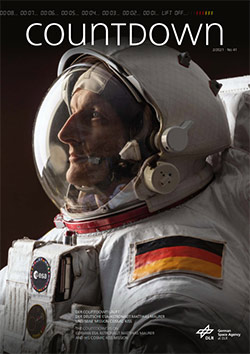
On Friday, November 12, 2021 at 0:32 Central European Time, the time had finally come: After a 22-hour flight in the Crew Dragon capsule, German ESA astronaut Matthias Maurer arrived on the International Space Station ISS together with NASA astronauts Raja Chari, Thomas H. Marshburn and Kayla Barron. Matthias Maurer is the first German to fly to the ISS with a commercial Crew Dragon capsule from the U.S. space company SpaceX. He will live and work there for around six months before returning to Earth in April 2022. DLR is involved in its "Cosmic Kiss" mission in a variety of ways. Since the beginning of 2021, the former DLR Space Administration has a new name: German Space Agency at DLR. With the new name, the role has also changed.
COUNTDOWN 40
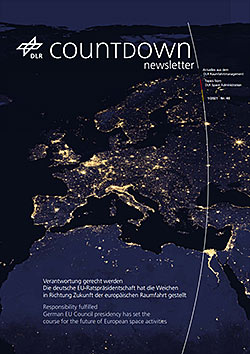
Ariane launches from the European spaceport in Kourou, the visit of the Rosetta space probe to comet Churyumov-Gerasimenko, or Galileo and Copernicus, the flagship programmes for navigation and Earth observation: All these are examples of successful European cooperation in major space missions and programmes. They show that the space sector - perhaps more than any other field - depends on international cooperation. Only in this way can it fully develop its potential in the service of people, the economy and the environment. At the European level, there are numerous larger and smaller organisations making their contribution. From July 1 to December 31, 2020, Germany held the presidency of the Council of the European Union. During this six-month period, a new seven-year budget and the new regulation on the EU space programme were negotiated and adopted.
COUNTDOWN 39
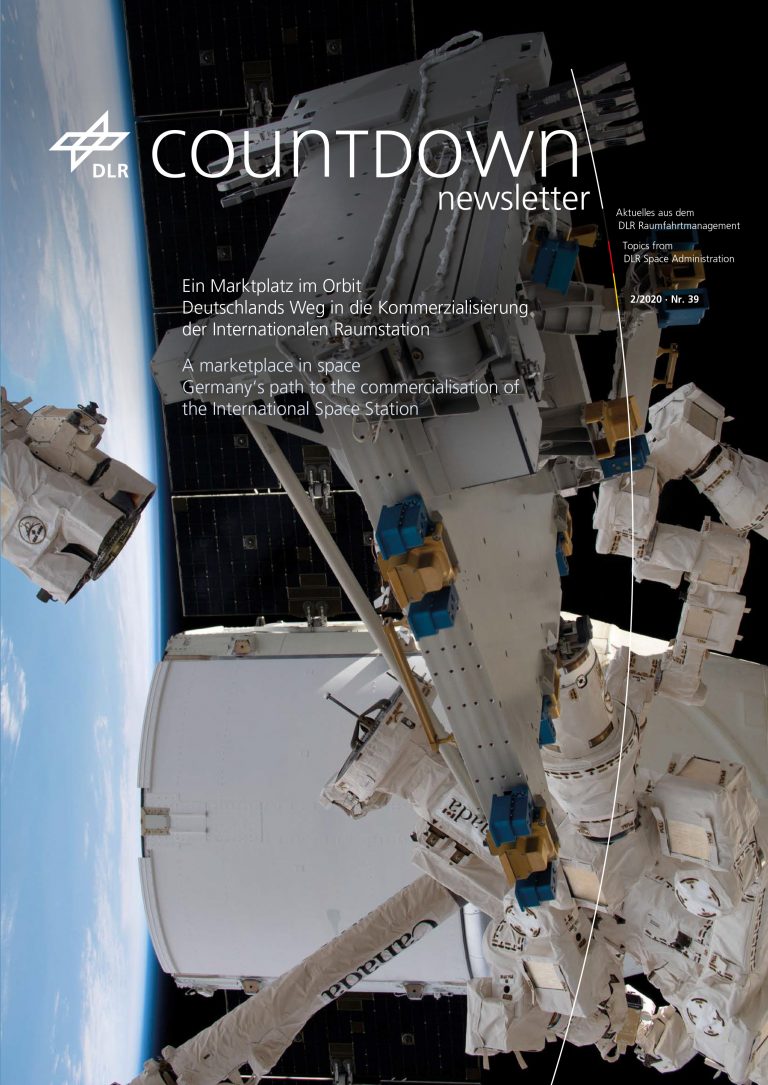
To relieve the strain on national budgets, the U.S. space administration began expanding the Earth economy to low Earth orbit 15 years ago through the NASA Authorization Act. To do so, it opened its ISS laboratories to domestic commercial research. Then, in January 2006, it added ISS transportation. As a result, the Dragon (SpaceX) and Cygnus (Northrop Grumman) space capsules have been regularly supplying the ISS with goods since October 2012. Sierra Nevada's Dream Chaser and Blue Origin's New Glenn are scheduled to follow from 2021. With the departure of Bob Behnken and Doug Hurley in "Crew Dragon" (SpaceX) to the space station, a new ISS era has begun on May 30, 2020 with the first astronautical commercial flight in the "Commercial Crew Programme". Boeing plans to follow suit with the "Starliner" in the near future. In this COUNTDOWN, you can find out how Germany and Europe are participating in ISS commercialization.
COUNTDOWN MK2019
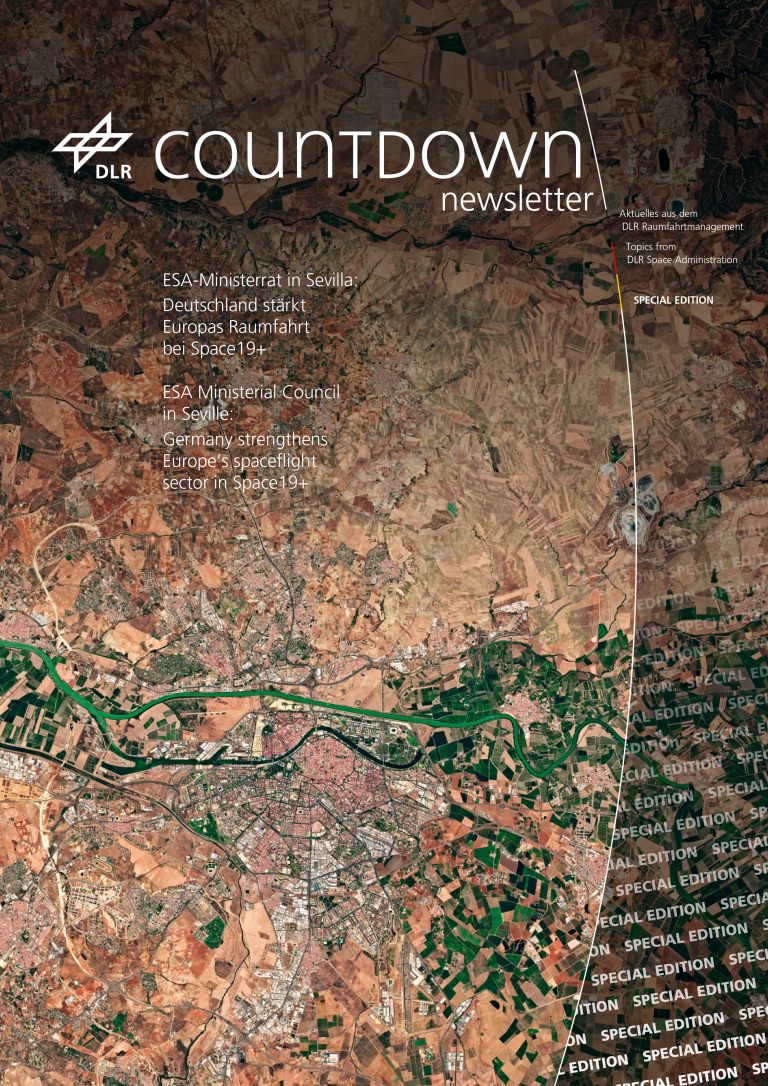
The Council Meeting on Ministerial Level of the European Space Agency ESA is the highest political decision-making body that defines the content and financial framework for ESA's space programmes every two to three years. Three years after the last conference in Lucerne, Switzerland, government representatives from 22 ESA member states met in Seville, Spain, on November 27-28, 2019, and subscribed a total of 14.5 billion euros for space programmes in the coming years as part of Space19+.
COUNTDOWN 38
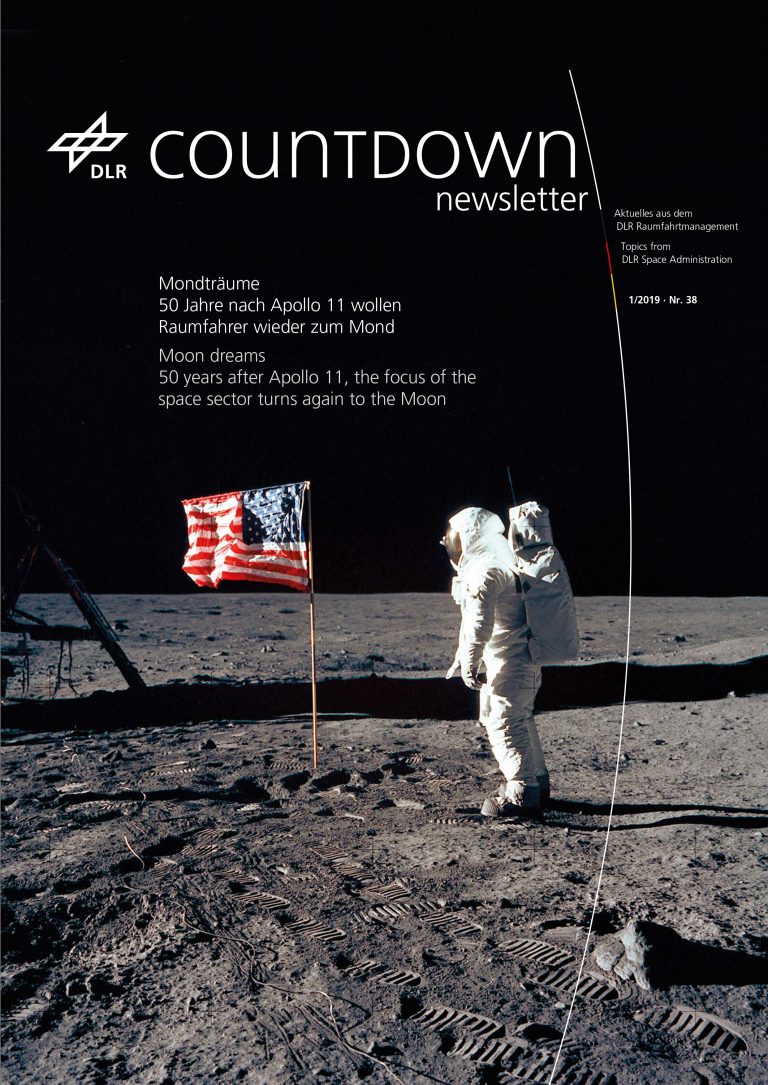
This year marks the anniversary of a fantastic event: 50 years ago - at 3:56 a.m. CET on July 21, 1969 - Neil Armstrong became the first man to set foot on the moon. The first lunar landing mission by Apollo 11 heroes Neil Armstrong, Edwin "Buzz" Aldrin and Michael Collins changed the world and set new standards in astronautical space flight. At the time, 500 to 600 million people tuned in to the 28-hour live broadcast. 50 percent of all television stations were tuned in when Armstrong and Aldrin became the first humans ever to leave the first footprints on another celestial body. To mark this unprecedented event in world history, we have published a detailed report on the international moon missions in this issue.
COUNTDOWN 37

When the European-Japanese planetary mission BepiColombo was launched into space aboard an Ariane 5 rocket from the Kourou Cosmodrome in French Guiana at 3:45 a.m. Central European Summer Time on October 20, 2018, on the one hand an incredible journey into the heart of our solar system began. On the other hand, the launch also marks the end of an exciting development story. It was already clear more than 25 years ago that BepiColombo would be the most extensive European project ever to explore a planet in our solar system.
COUNTDOWN 36
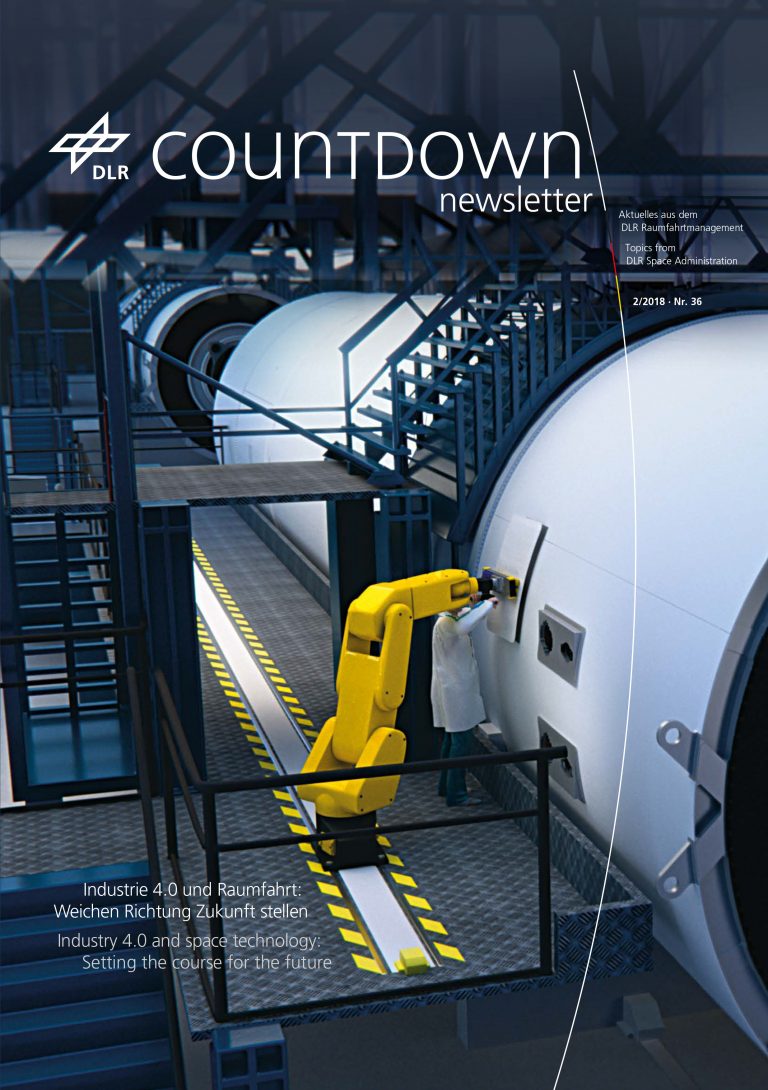
Industry 4.0 and digitisation are on everyone's lips right now. Experts and politicians agree: Companies that don't jump on board will miss the important train to the future. After all, production without Industry 4.0 will no longer be cost-efficient. However, not all technology sectors have set the course for the future to the same extent. It is also difficult to do so because not all industries have the same prerequisites that are necessary for Industry 4.0. While series production prevails to the greatest possible extent in the automotive industry, satellites are still generally one-offs. However, many Industrie 4.0 approaches are somewhat independent of series production and can also be transferred to the manufacture of space systems. Particularly in the case of complex components - such as space goods - fully networked digitisation offers great potential.
COUNTDOWN 35
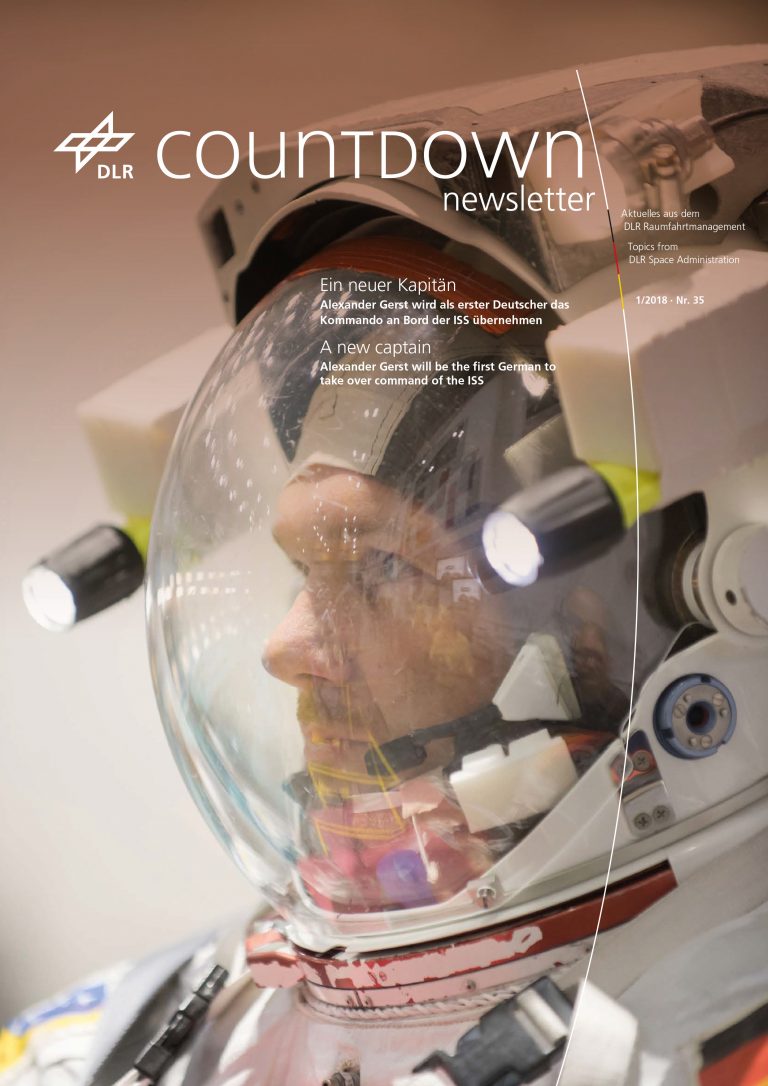
Every ship needs a captain who keeps his crew together, masters crises on board and guides his sailors through rough stormy seas to safe harbour. The International Space Station ISS also needs such an experienced astronaut to guide the crew - unimpressed by the rough space weather - purposefully through their mission and safely back to Earth at the end. This task will be performed by a German for the first time ever at the end of August 2018. Alexander Gerst, an astronaut with the European Space Agency (ESA), will lead his crew on their journey through space, setting off for new horizons in science and society. During his 187-day mission "horizons - Knowledge for Tomorrow," he will conduct numerous experiments on the topics of "Health, Society, Environment and Climate Change" as well as "Digitalisation, Industry 4.0, Energy and Mobility of Tomorrow."
COUNTDOWN 34
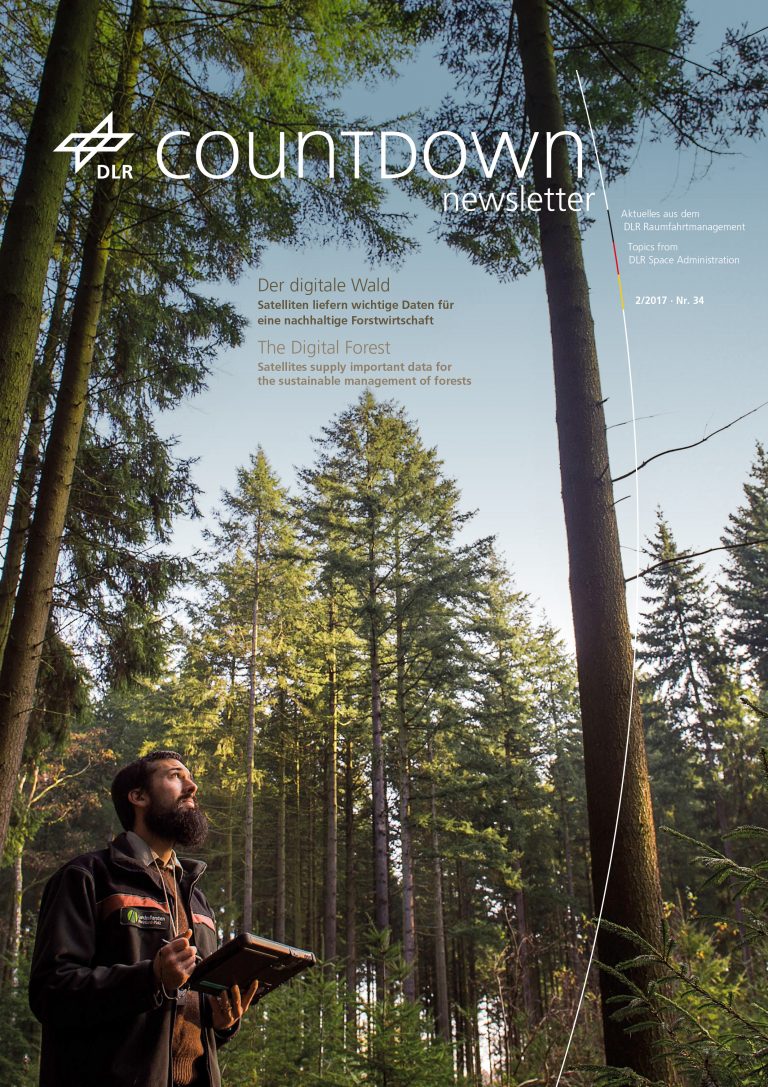
The profession of foresters has changed: Today, the "guardians of the forest" not only protect plants and animals in their hunting grounds. Above all, they have to manage the forests as sustainably as possible as good merchants - a huge responsibility. As managers of the complex ecosystem, today's foresters have to know almost everything: Mathematics, biology, zoology, botany, surveying, forest law and IT. In addition, they have another important task: a nationwide forest inventory. In Rhineland-Palatinate in particular, this is a mammoth task, because it is the state with the highest proportion of forest: 42.3 percent of the state is covered by trees - far more than the national average. This is a major challenge, as 1,650 foresters have to look after 531 million trees. In a pilot project supervised by the German Space Agency at DLR, a process is currently being developed that will quickly feed satellite data into the daily work of offices, forests and the timber industry - forestry is going digital.
COUNTDOWN 33
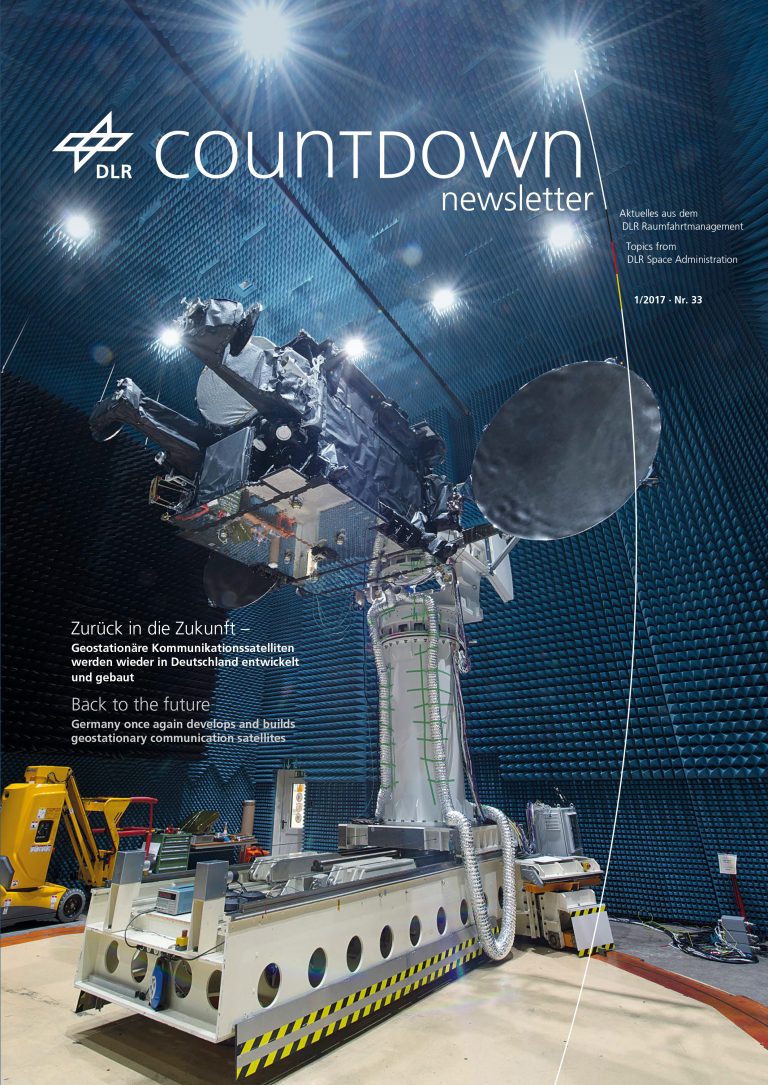
Since the launch of the Hispasat 36W-1 satellite, German industry has catapulted itself "back into the future" in the system area of building geostationary communication satellites virtually overnight. It is based on the SmallGEO platform developed and built in Germany, thus closing a major gap. This is because the DFS-Kopernikus programme, which was commissioned by the German Federal Post Office, was the last German communication satellite to go into space in the early 1990s. SmallGEO is now proving that Germany is once again capable of developing and building complete communication satellites. This is an important milestone, because the telecommunications business will continue to be an indispensable element of our increasingly digitalised society.
COUNTDOWN MK2016

On December 1 and 2, 2016, the ministers and state secretaries responsible for space from the 22 member states of the European Space Agency (ESA) and the associate members Canada and Slovenia met in Lucerne to set the course for joint space projects in the coming years. Here, important decisions were made in the areas of launchers, manned spaceflight, ISS, research under space conditions, exploration, extraterrestrials, Earth observation, satellite communications, satellite navigation, technology development and the space situation. With almost equal contributions of nearly two billion euros each, Germany and France will continue to be the main pillars of ESA in the future. In addition to its participation in the International Space Station (ISS), the German focus was on strengthening the application programs.
COUNTDOWN 32
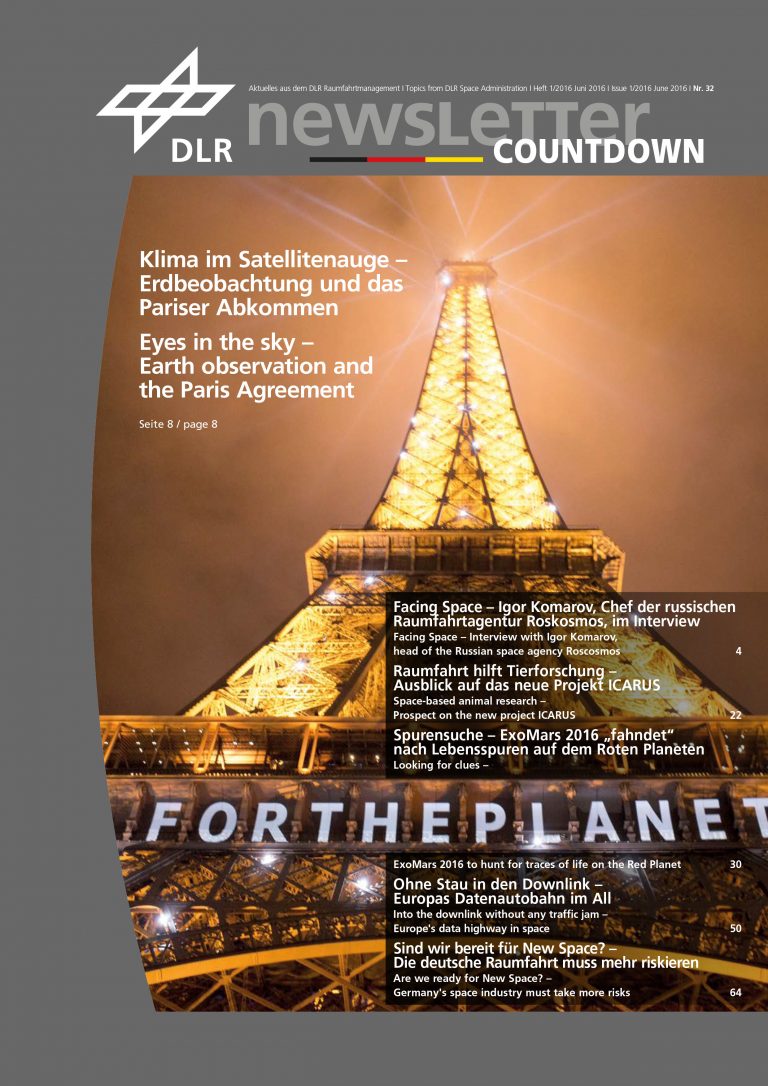
Climate change is not a future scenario, but reality. For example, the atmospheric concentration of the greenhouse gas carbon dioxide has risen by 25 percent and the average global temperature by 0.6 degrees Celsius in the past 50 years. The cause is our modern way of life in industrial societies: the burning of fossil fuels, deforestation and factory farming. Greenhouse gases in the atmosphere reduce the radiation of heat and thus lead to the temperature increase. At the World Climate Conference in Paris, it was decided to limit global warming to well below two degrees Celsius relative to pre-industrial levels - if possible, even to 1.5 degrees Celsius.
COUNTDOWN 31
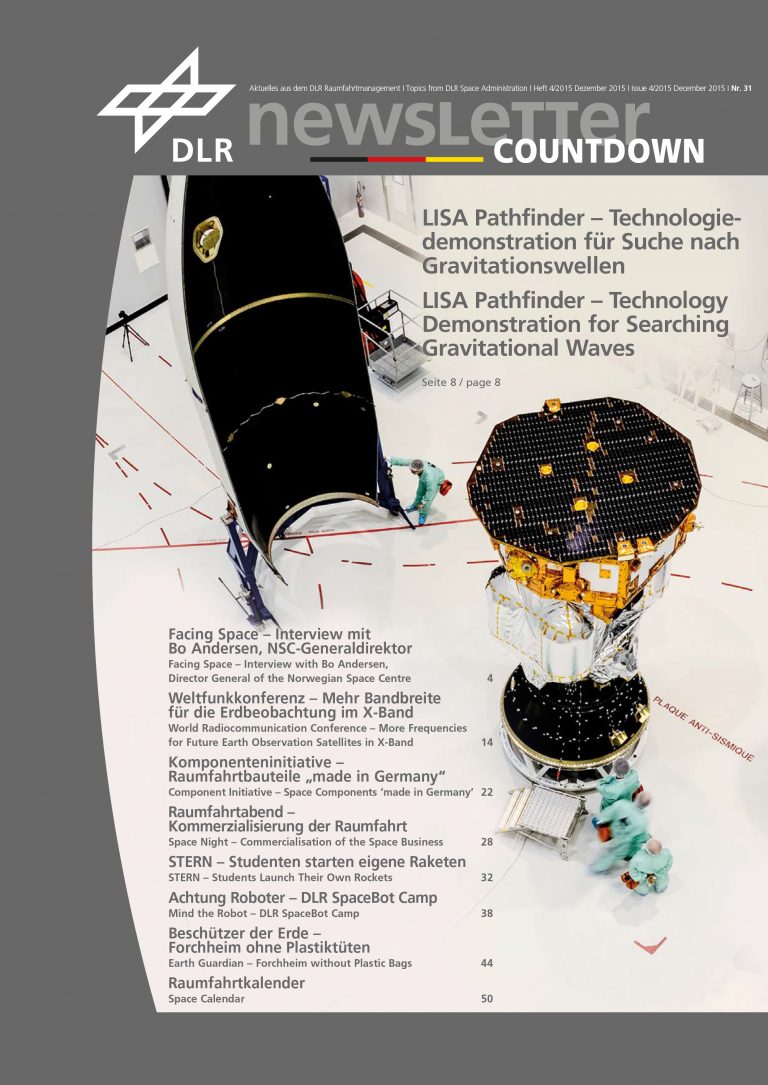
Following in Einstein's footsteps: Almost exactly 100 years to the day after Albert Einstein published his theory of general relativity, the scientific technology demonstration mission LISA Pathfinder was launched into space from the European spaceport in Kourou (French Guyana) on December 3, 2015. With the sixth flight of the Vega launch vehicle, the mission lifted off shortly after 5 a.m. Central European Time. After ten years of development work, LISA Pathfinder will now pave the way for the eLISA (evolved Laser Interferometer Space Antenna) space observatory, which will "observe" the tiniest oscillations of space-time - so-called gravitational waves - and thus track down the most energetic and violent astrophysical events in our universe.
COUNTDOWN 30
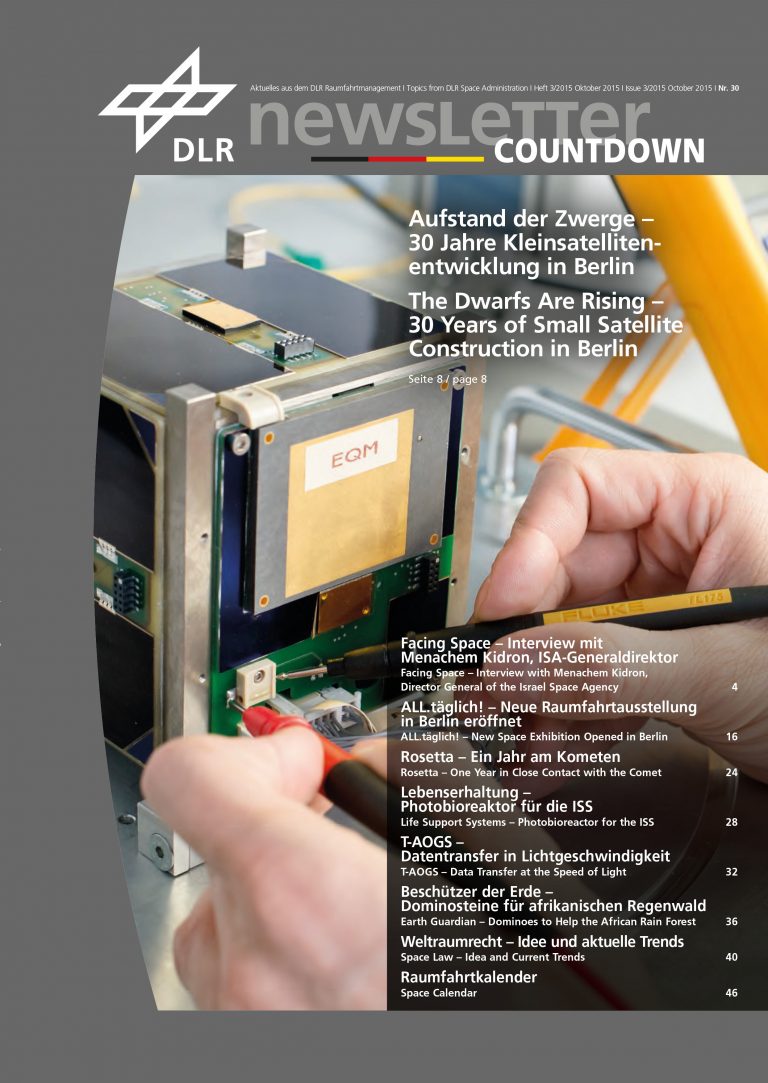
There is also a drive for miniaturization in space technology. Satellites are becoming smaller and smaller to complement large platforms. More and more of these small satellites are orbiting our Earth. The so-called pico class has an edge length of just ten centimeters and weighs less than one kilogram. This makes the launches of these satellites very inexpensive. This development gives companies and universities the opportunity to launch their own space missions. In America, for example, Google has been pushing harder since 2013 to use small satellites to connect "the remaining three billion" people without Internet to the online world. In Germany, the Technical University of Berlin made the leap into space much earlier. As early as July 1991, the first Berlin small satellite, TUBSAT-A, orbited our Earth. DLR has accompanied the Chair of Astronautics at the Institute of Aeronautics and Astronautics on its way into space from then until today.
COUNTDOWN 29
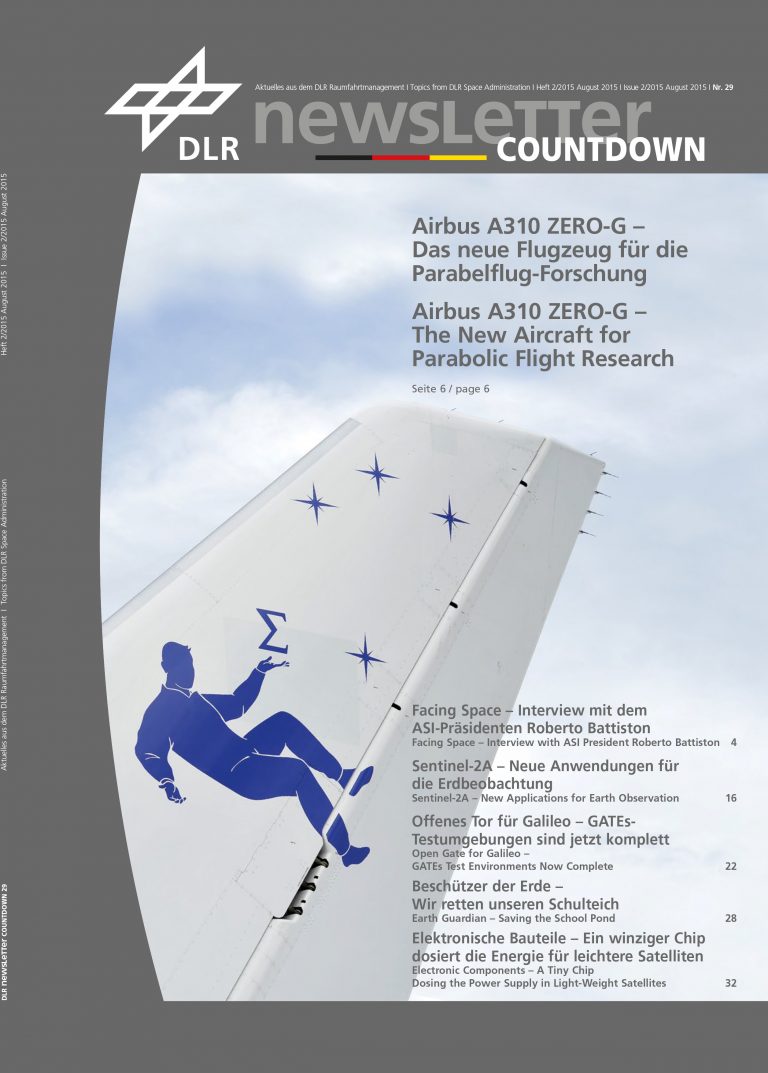
When the Airbus A310 ZERO-G landed at Bordeaux-Mérignac Airport at 12:35 p.m. on May 7, the first campaign with the new parabolic aircraft came to a successful end after three days of flight. This first joint parabolic flight campaign by DLR, the European Space Agency (ESA) and the French space agency CNES for experiments under pure weightlessness marked the inauguration of the A310 ZERO-G. The A310 ZERO-G is the first parabolic aircraft to be flown by the French space agency CNES. This makes the converted former "Chancellor's Airbus" the new bridge for experiments on their way to the International Space Station. The Airbus A310 ZERO-G offers several advantages over its predecessor: For example, scientists have more energy available for their experiments than in the Airbus A300 ZERO-G. Although the new parabolic aircraft is nine meters shorter, there is also one hundred square meters of space available for experiments inside the cabin.
COUNTDOWN 28
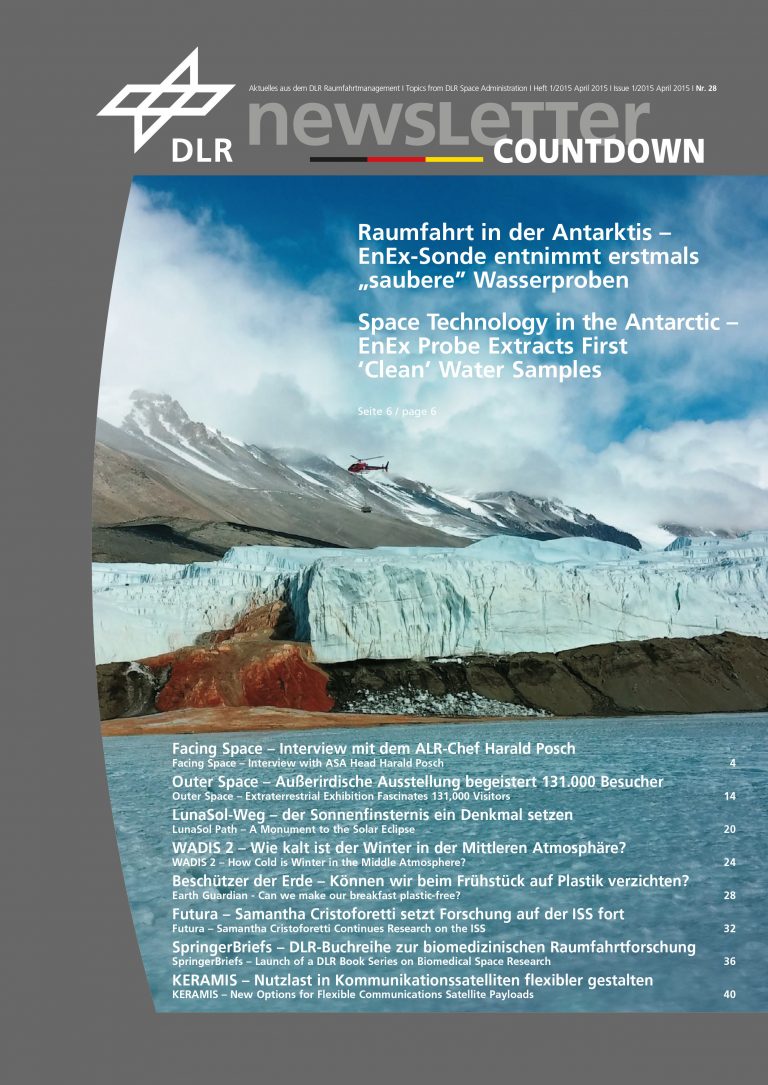
Without water - no life: This principle applies to the Earth, but presumably also to other celestial bodies. Water that has been hidden under a thick layer of ice for millions of years can tell us something about the origin and development of life. When recovering such a sample, however, care must be taken not to introduce microorganisms from the surface and contaminate the sample and the underwater biotope. For the first time ever, the Enceladus Explorer (EnEx) project of the DLR Space Agency has succeeded in taking a contamination-free, subglacial water sample with a meltdown probe - the so-called IceMole - and bringing it to the surface. What has now been achieved at the Antarctic "Blood Falls" on Earth should one day also be possible on Saturn's moon Enceladus.
COUNTDOWN 27

Nov. 12, 2014; 4:32 p.m.; 509,500,000 kilometers from Earth: 20 years after work began on the European Rosetta space mission and more than a decade after launch, its daughter probe Philae touched down on the surface of comet 67P/Churyumov-Gerasimenko. Until then, everything was going according to plan. Philae had hit the target point in landing area J - christened "Agilkia" - to within about 100 meters. This marked the culmination of a 30-year mission. Indeed, the Rosetta mission has a long history: In 1984, the European Space Agency (ESA) adopted the four so-called "Cornerstone" missions in its long-term "Horizon 2000" program - one of them as a journey to primordial bodies. This actual sample return mission then gave rise to Rosetta, which deposited the lander Philae on comet 67P/Churyumov-Gerasimenko thirty years later.
COUNTDOWN 26
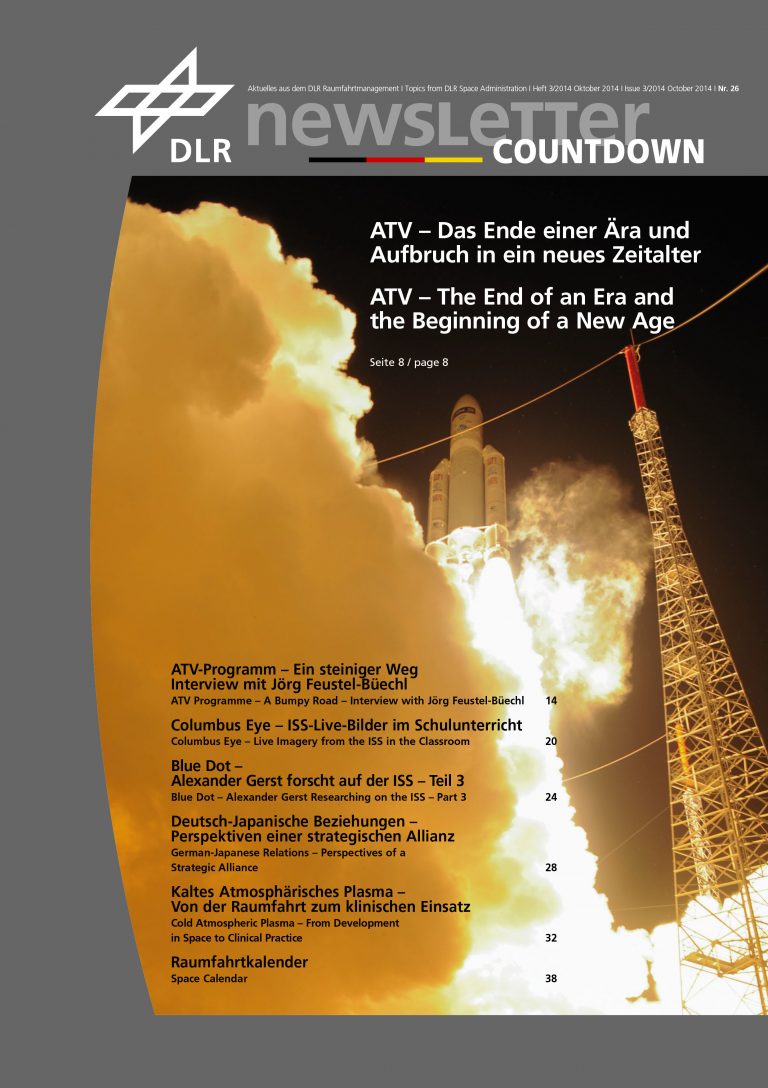
The narrow crescent moon is still above the horizon. Countless bats catch the insects attracted by the few light sources on the observation deck. A starry night sky over Kourou (French Guiana) offers the best view - all the omens for a perfect launch. Out of the dark jungle night rises the launch vehicle, ready for takeoff five kilometers away, standing in the cone of several floodlights. On board Ariane 5 VA 219 is the last Automated Transfer Vehicle (ATV-5). The fully automated European Space Transporter "Georges Lemaître" departed on its final mission at 1:47 a.m. Central European Summer Time (CEST) on July 30, 2014, and automatically docked with the International Space Station (ISS) at precisely 3:30 p.m. on August 12, 2014.
COUNTDOWN 25
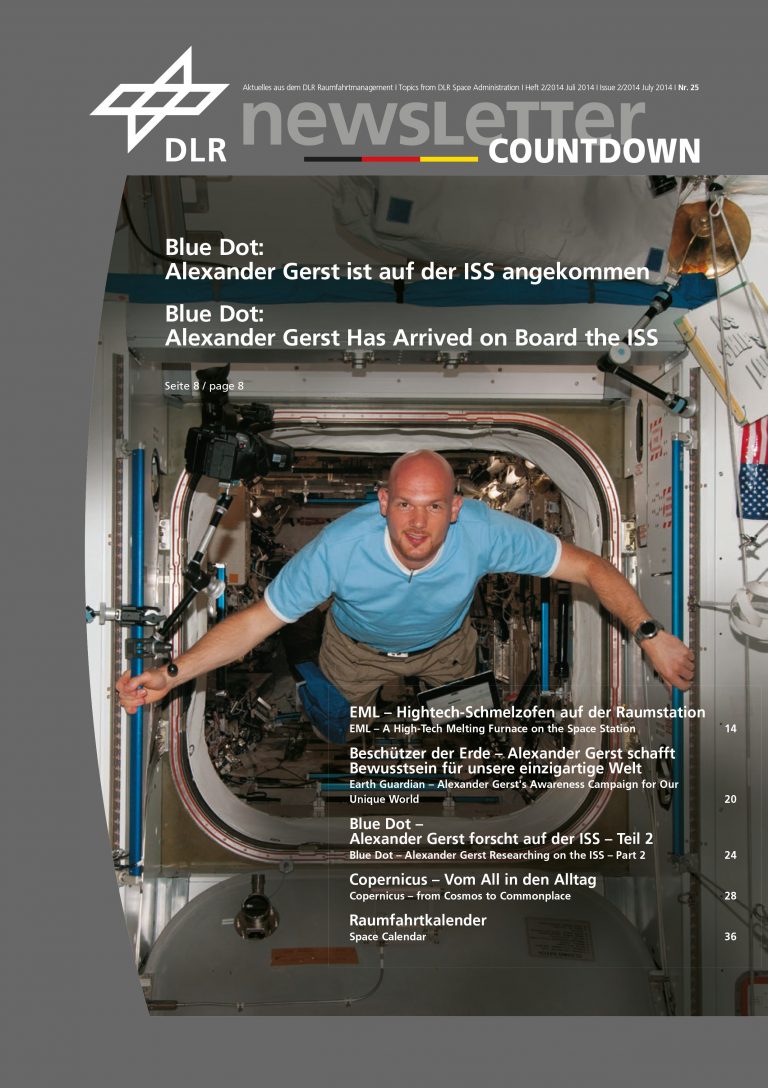
At 9:52 a.m. (5:52 a.m. CEST) on May 29, there is a sigh of relief at the Kazakh cosmodrome in Baikonur: After 27 long minutes of waiting, the hatch separating the Soyuz spacecraft from the International Space Station (ISS) finally opens. A head appears at the other edge of the hatch - we've seen the broad grin on this face since boarding the crew bus in the direction of the launch pad - slowly moves toward the ISS connecting door - the so-called "hatch" - and turns toward cosmonaut Oleg Artyemyev. German ESA astronaut Alexander Gerst is the first new arrival to float into the space station - the start of his "Blue Dot" mission. After a warm hug from the crew on board, the two comrades Reid Wisemann (USA) and Maxim Surayev (Russia) are finally allowed to enter the station through the hatch.
COUNTDOWN 24
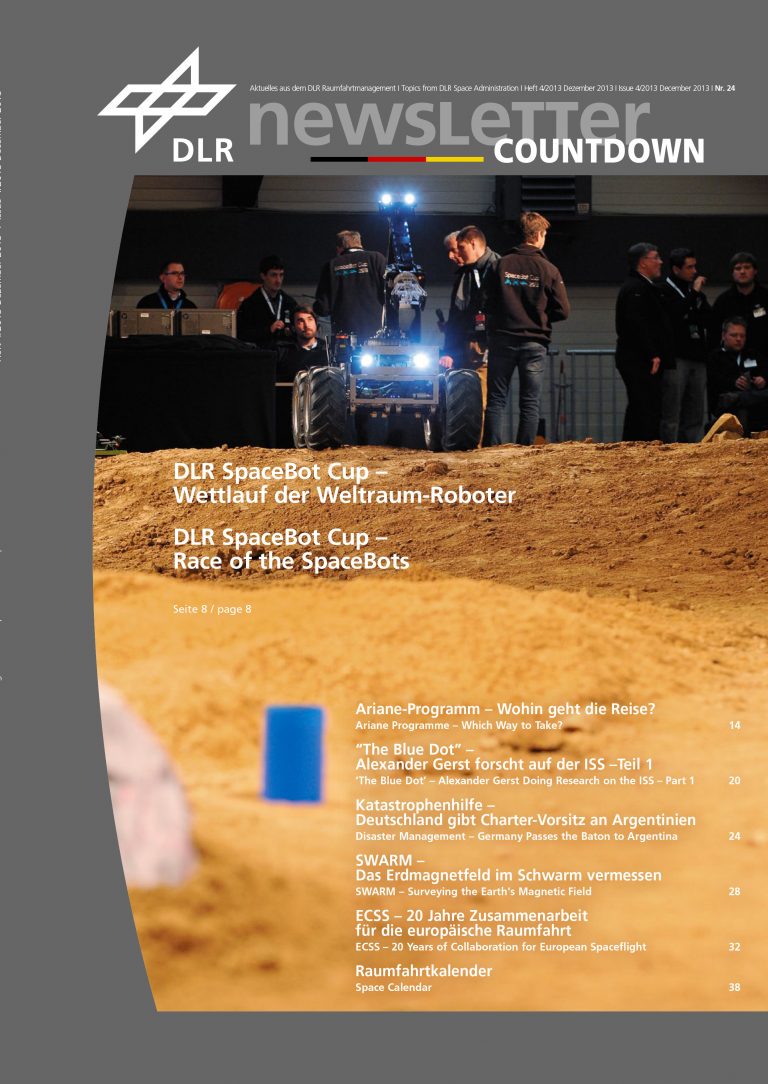
Robots will play a major role in the coming missions to other planets in our solar system. Germany must be ready for this and have the necessary technology in the drawer. To prepare German universities and companies for this appearance, the Space Agency has launched the DLR SpaceBot Cup - Germany's first space robotics competition and a competition of a very special kind. To this end, DLR Space Management transformed the Supercrosshalle in Rheinbreitbach near Bonn into a space landscape on November 11 and 12, 2013. There, ten robot systems competed against each other to win the DLR SpaceBot Cup - but there was no winner. The DLR SpaceBot Cup was set up like a real space scenario: Each robot system started with a rough map of its surroundings. Shortly after "landing," the robot system then went on an exploratory trip on the Rheinbreitbach planetary surface.
COUNTDOWN 23
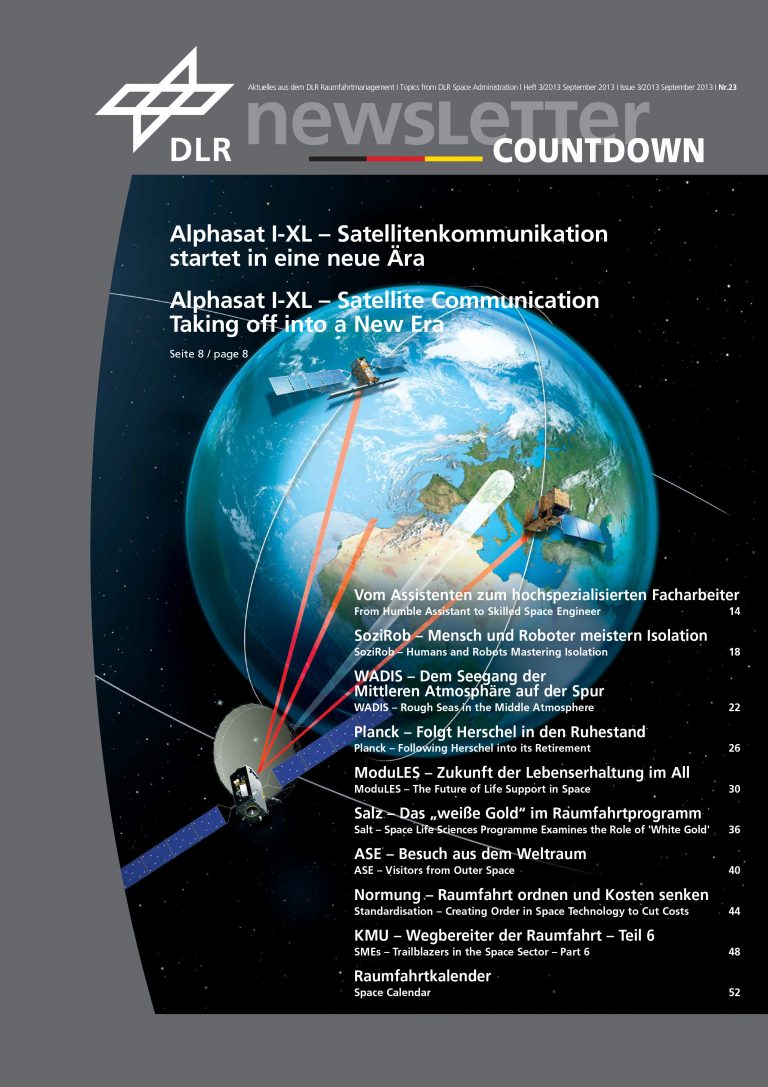
Information dominates our everyday lives. Ever-growing volumes of data have to be transported around the globe. Satellite communications play a key role in ensuring that this information reaches us reliably. Cutting-edge German technology was on board when Alphasat I-XL, ESA's largest communications satellite to date, was launched into space from the European Space Agency's space center in Kourou (French Guyana) on board an Ariane 5 launch vehicle at 9:54 p.m. Central European Summer Time (CEST) on July 25, 2013. At an altitude of nearly 36,000 kilometers above Earth, the giant satellite is expected to revolutionize broadband communications over the next 15 years with its more than 750 L-band channels in mobile communications. In addition to the commercial payload, Alphasat I-XL also offers space for innovative technologies that will be tested for the first time under the special conditions of space. Of the four payloads flying on Alphasat for demonstration purposes, two are from Germany.
COUNTDOWN 22
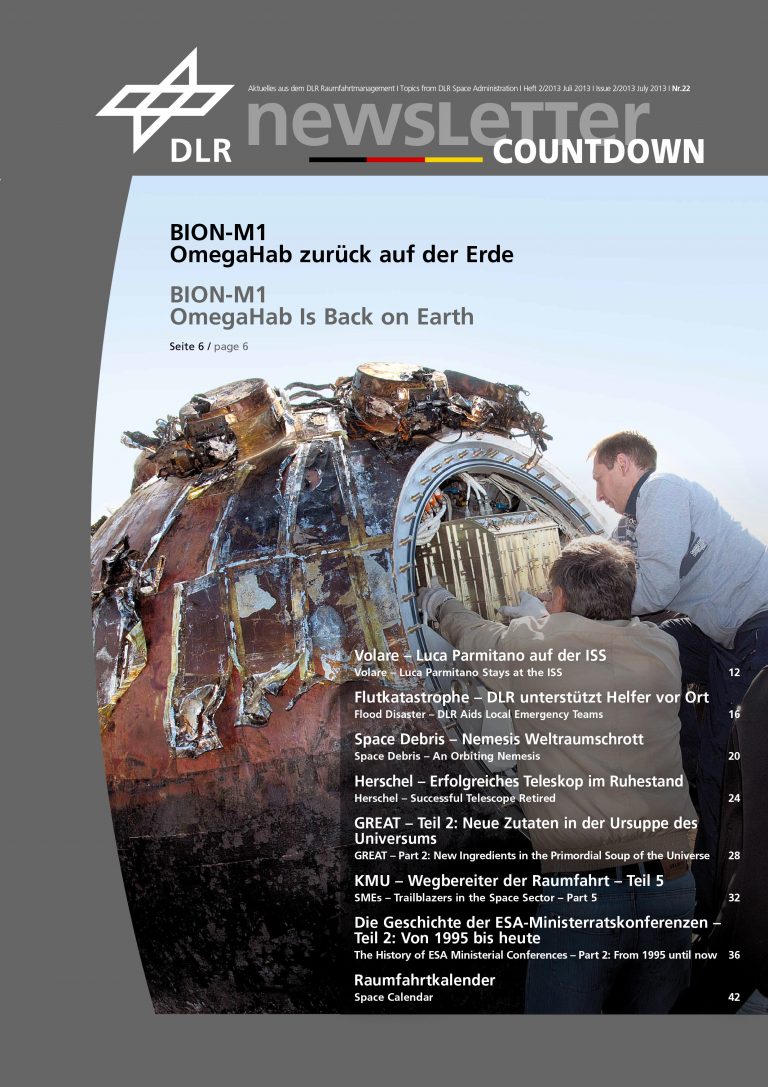
After 30 days in space, the unmanned Russian BION-M1 return capsule landed in the middle of a sunflower field in southern Russia on May 19, 2013. This marked the end of the DLR-funded mini-ecosystem project "OmegaHab" for the German scientists. In this mini-ecosystem, single-celled algae (Euglena gracilis), also known as eye animals, the aquatic plant hornwort (Ceratophyllum demersum), 55 cichlid larvae (Oreochromis mossambicus), Mexican stream fleas (Hyalella azteca) and some post horn snails (Biomphalaria glabrata) were sent on their journey into space. In zero gravity, the artificial mini-ecosystem consisting of two chambers with its own nutrient and gas exchange should function as a bioregenerative life support system. The algae and hornwort produced the oxygen for the fish, crabs and snails. The carbon dioxide released by the animals, in turn, was utilized by the plants in their photosynthesis - a closed cycle of life 575 kilometers above the Earth.
COUNTDOWN 21
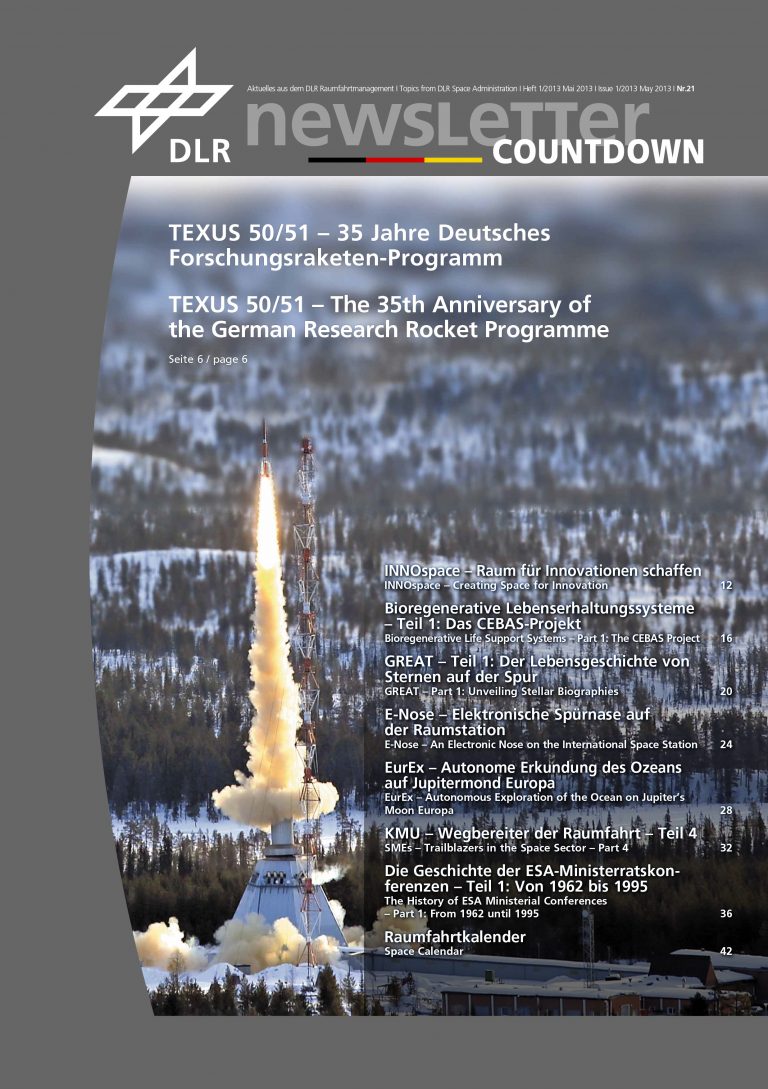
The world's longest rocket program for research in weightlessness is celebrating an anniversary: 35 years after the first TEXUS mission in December 1977, the 50th TEXUS rocket was successfully launched into space on April 12, 2013, from the Esrange Space Center near Kiruna in northern Sweden. The research rocket "VSB-30" of the German Aerospace Center (DLR) carried four German experiments from biology and materials research to an altitude of 261 kilometers. The main payload was the German-developed Electromagnetic Levitation Facility (EML), which scientists from the DLR Institute of Materials Physics in Space are using in two experiments to research thermophysical properties and the solidification behavior of metal alloys.
COUNTDOWN MK2012
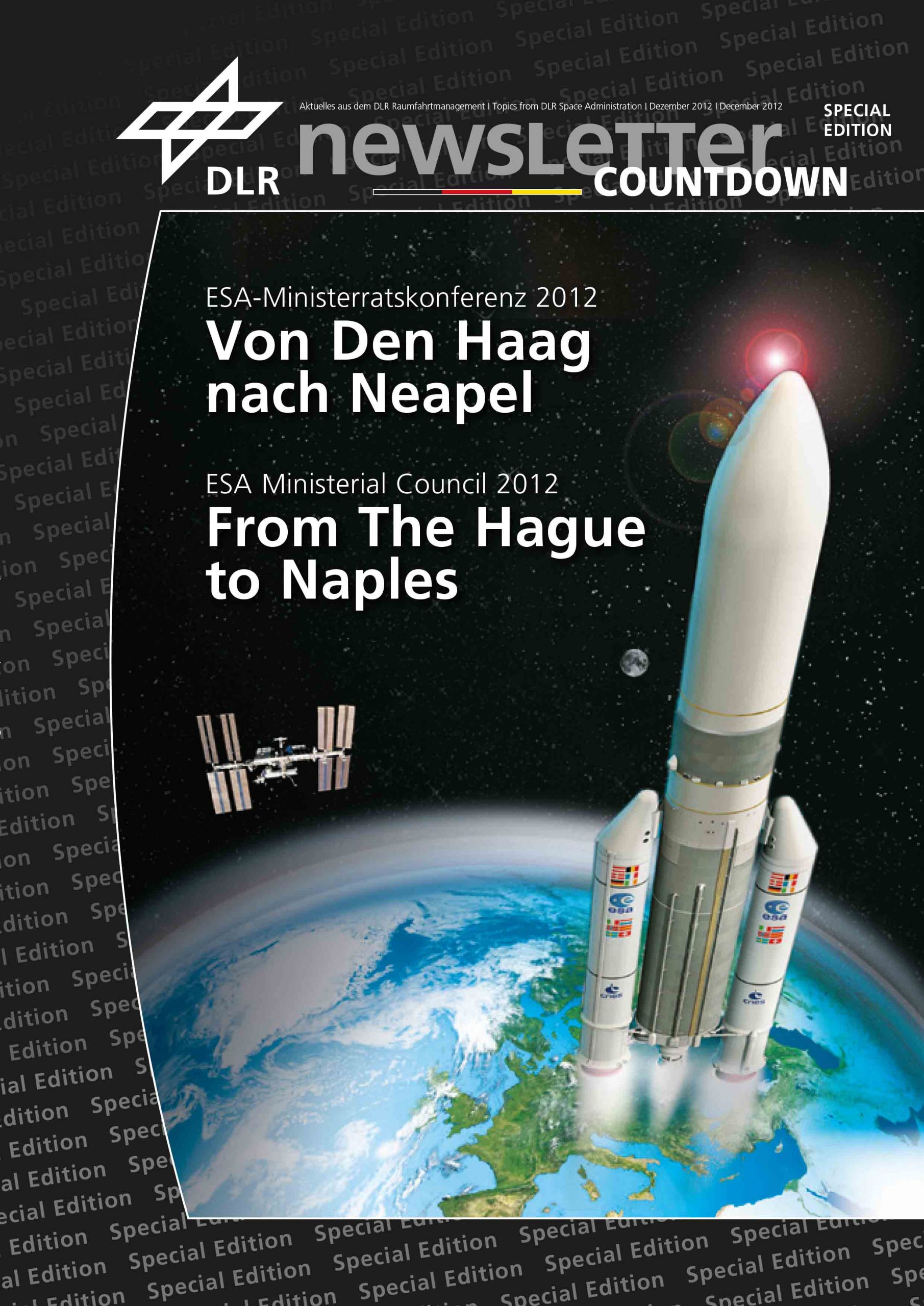
Naples was the focal point of space travel from November 20 to 21, 2012. At the "Mostra d'Oltremare" congress center in the Mediterranean metropolitan region not far from Mount Vesuvius, the member states of the European Space Agency ESA set the course for space travel in the coming years and found answers to hot questions: What will happen with the Ariane rocket? What about the International Space Station (ISS) and thus also research in weightlessness? Which distant planets will we set off for to unlock their secrets? The German government has also sent a delegation to the Gulf of Naples to represent Germany's interests at the Ministerial Council Conference of the European Space Agency ESA. The German government will contribute 2.6 billion euros to the ten-billion-euro ESA budget over the next few years, making it the largest contributor in Europe.
COUNTDOWN 20

The satellite orbits around our Earth are like our highways: they are lifelines and are used to varying degrees. In space, too, there are accidents between satellites, former rocket parts or fragments of old discarded orbiters - so-called space junk. That's why we on Earth need to be acutely aware of the situation in space: Is there a threat of collision or atmospheric entry? What would be the consequences? Are there contingency plans? The Space Situation Center provides answers to these questions. Its military and civilian staff provide status and function overviews of satellites with German participation, warn the responsible ministries in the event of potential danger or calculate evasion scenarios.
COUNTDOWN 19

Blue energy on the cover of the current issue of COUNTDOWN: Thanks to the speed of xenon ions, probes will in future fly through the universe electrically powered and satellites will correct their orbit around the Earth. If these electric propulsion systems are combined with chemical propulsion systems in a launch vehicle, more energy-efficient space travel will be possible in the future. With their enormous thrust, chemical propulsion systems help probes and satellites overcome gravity and air resistance. They carry the rocket and satellite into the planned orbit. Once there, the orbit and orientation of the satellite in a vacuum can be controlled much more effectively with electric thrusters than with chemical ones. A high specific impulse is crucial for locomotion in space. The High Efficiency Multi Stage Plasma (HEMP) engine uses ionized xenon gas to achieve a specific impulse five times higher than the best chemical engines.
COUNTDOWN 18

On March 6 and 7, 2012, DLR Space Management organized the Second National Conference on Space Robotics in coordination with the German Federal Ministry of Economics and Technology (BMWi). Here, the progress achieved since 2009 was presented. In addition, a roadmap was presented that defines programmatic goals for the coming years. Read more about the focal points of German space robotics in the cover story of COUNTDOWN 18.
COUNTDOWN 17

On November 17, 2011, at 19:38 local time (12:38 Central European Time, CET), the Chinese spacecraft Shenzhou-8 landed on schedule in Gansu Province - the Chinese part of the Gobi Desert. On board was the SIMBOX, a German research laboratory for biological and medical experiments in miniature. In a total of 17 experiments, plants, nematodes, snails, bacteria and human cancer cells were exposed to weightlessness and the radiation of space during the two-and-a-half-week mission. How the SIMBOX is constructed, which experiments took place there and the significance of this German-Chinese mission is the cover story of COUNTDOWN 17.
COUNTDOWN 16
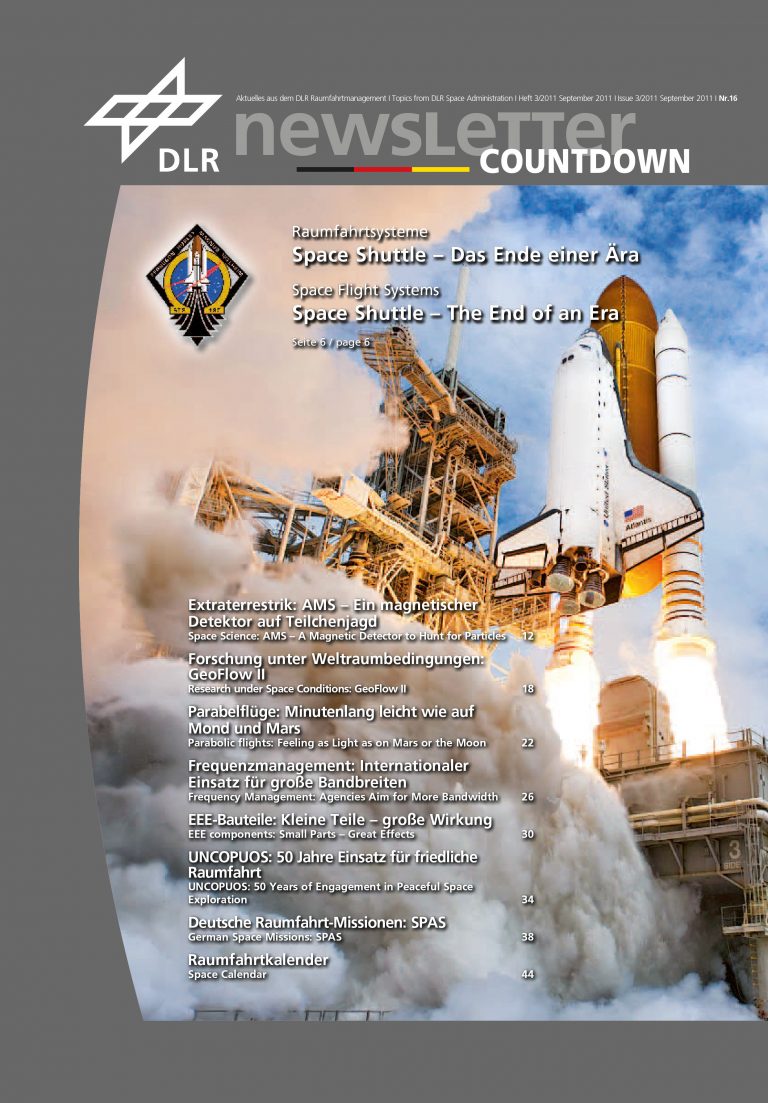
On July 21, 2011, at 5:57 a.m. local time (11:57 a.m. CET), a space shuttle landed for the last time in history. For 30 years, the space shuttles symbolized America's claim in manned spaceflight - after 135 missions, this era is now coming to an end. In total, the space shuttles have circled the Earth more than 21,150 times, covering more than 870 million kilometers, carrying 355 people from 16 countries into space and spending 1333 days in orbit. The end of the shuttle era is the cover story of COUNTDOWN 16.
COUNTDOWN 15
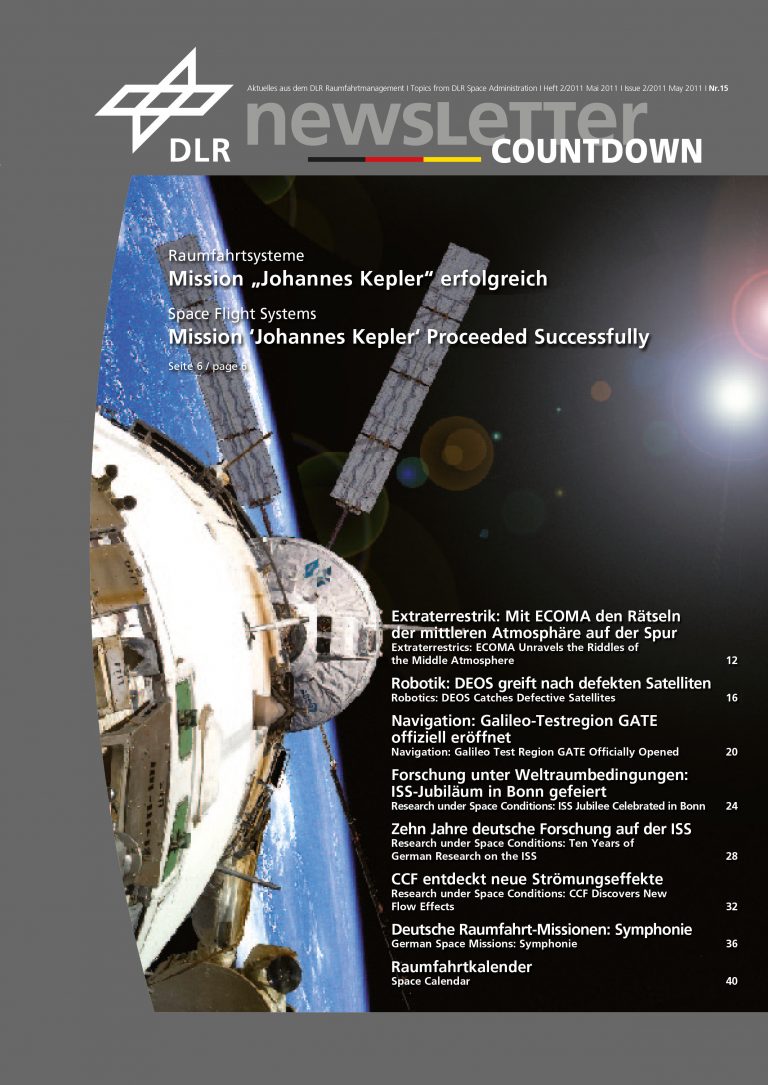
The cover story of COUNTDOWN 15 is the successful launch of the Automated Transfer Vehicle ATV-2 "Johannes Kepler". On February 16, 2011, the European space transporter set off on an Ariane 5-ES rocket from Kourou to the International Space Station ISS. The ATV-2, named after the German mathematician and astronomer Johannes Kepler, then docked at the Russian Zvezda module on Feb. 24, 2011, supplying the space station with a total of seven tons of supplies. The European space transporter will remain at the ISS until June 20, 2011, where it will perform orbital lifts of the space station, among other tasks.
COUNTDOWN 14
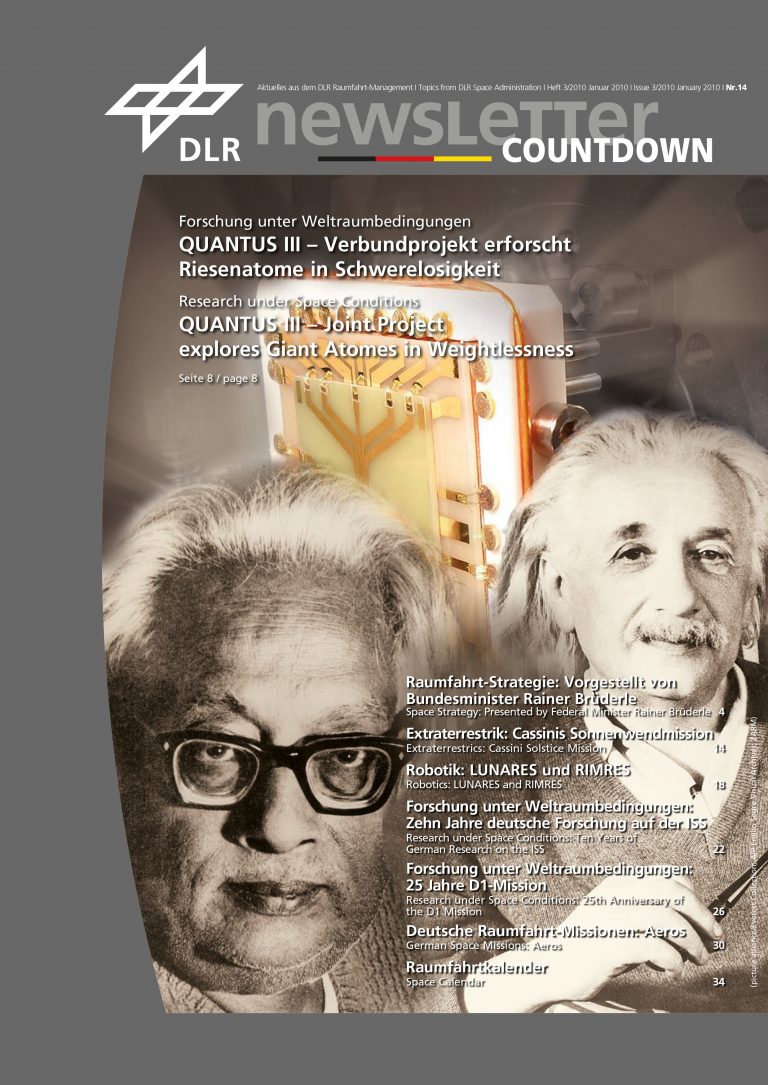
The cover story of COUNTDOWN 14 is the joint project QUANTUS III. If a cloud of several thousand individual atoms is cooled to just below minus 273.15 degrees Celsius near absolute zero, a millimeter-sized "giant atom" is created - a Bose-Einstein condensate (BEC). Among other things, the project should make it possible to explore BEC in space and thus put Einstein's theory of relativity to the test. On November 25, 2010, the Senate of the German Aerospace Center (DLR) unanimously elected Dr. Gerd Gruppe as a new member of the Executive Board for DLR Space Administration. In COUNTDOWN 15, we introduce Dr. Gruppe. In addition, the Federal Minister of Economics and Technology, Rainer Brüderle, presents the contents and goals of the new space strategy in a guest article.
COUNTDOWN 13
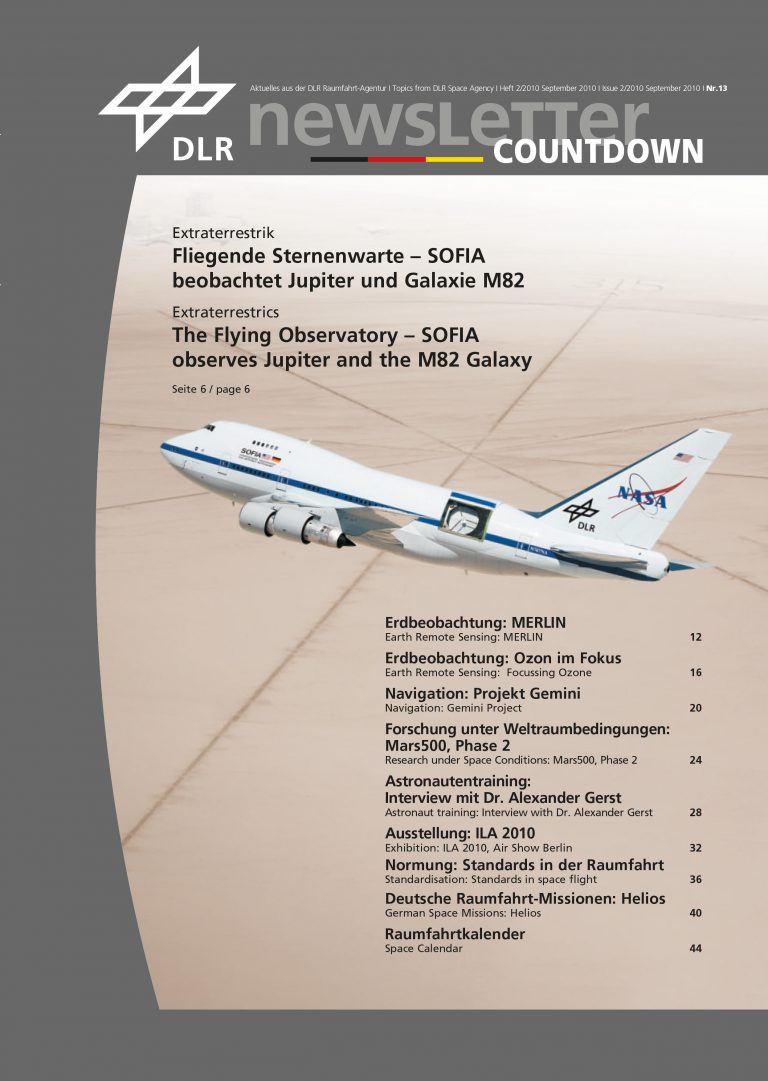
The cover story of COUNTDOWN 13 is the flying observatory SOFIA, a cooperation between DLR and NASA. The telescope, integrated into a Boeing 747 SP, has already captured its first images of Jupiter and the galaxy Messier 82. SOFIA is scheduled to begin scientific operations in early 2011. In addition, this issue contains an elevation model calculated from satellite data from TerraSAR-X and TanDEM-X. Also in Issue 13: the Franco-German MERLIN climate mission, the impact of the Montreal Protocol on the ozone layer, the Gemini project to test GNSS receivers, the second phase of the Mars500 isolation study, an interview with German astronaut candidate Dr. Alexander Gerst, a review of the International Aerospace Exhibition in Berlin, the impact of standardization on spaceflight, and the German-American Helios solar probe mission.
COUNTDOWN 12

As part of the relaunch of DLR's periodicals, COUNTDOWN will appear in a new look starting with issue 12. The cover story is about Earth remote sensing: The German radar satellite TanDEM-X is expected to be launched into space at the end of June. Together with TerraSAR-X, launched in 2007, the satellite will provide a global digital elevation model of the Earth's surface in unprecedented quality by 2013. Also in Issue 12: Europe's CryoSat-2 ice mission successfully launched on April 8 in its second attempt, the sun and Earth in the sights of the U.S. STEREO A and B probes at the start of the new solar cycle, spectacular images of the Earth's satellite thanks to the Japanese Kaguya (SELENE) lunar probe, Europe's spaceport in Kourou ahead of the first launch of Soyuz and Vega, the Nobel Prize in Chemistry for Ada Yonath, and a look back at the first German Azur satellite mission in 1969.
COUNTDOWN 11
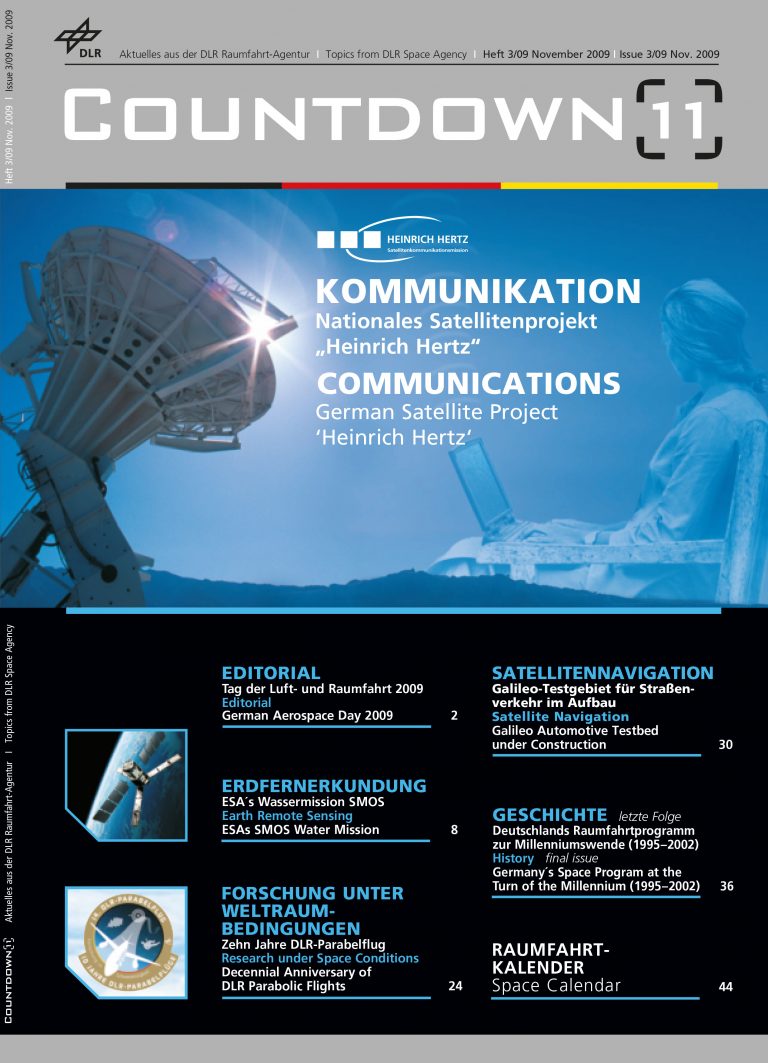
The national satellite communications project "Heinrich Hertz" has been launched with the signing of the feasibility study. In 2014, the orbiter is expected to be operational after definition of the mission concept and selection of service providers. COUNTDOWN 11 also deals with the following topics: Launch of the European mission for remote sensing of soil moisture and ocean salinity "SMOS," "BepiColombo" - the planned European-Japanese Mercury mission, findings of the U.S. Mars mission "Phoenix," DLR's tenth anniversary of parabolic flight, "aviationGATE," the German test field for road traffic applications in preparation for the European satellite navigation system "Galileo," and the last part of the series "History of German Space Flight": Germany's space program at the turn of the millennium (1995-2002).
COUNTDOWN 10
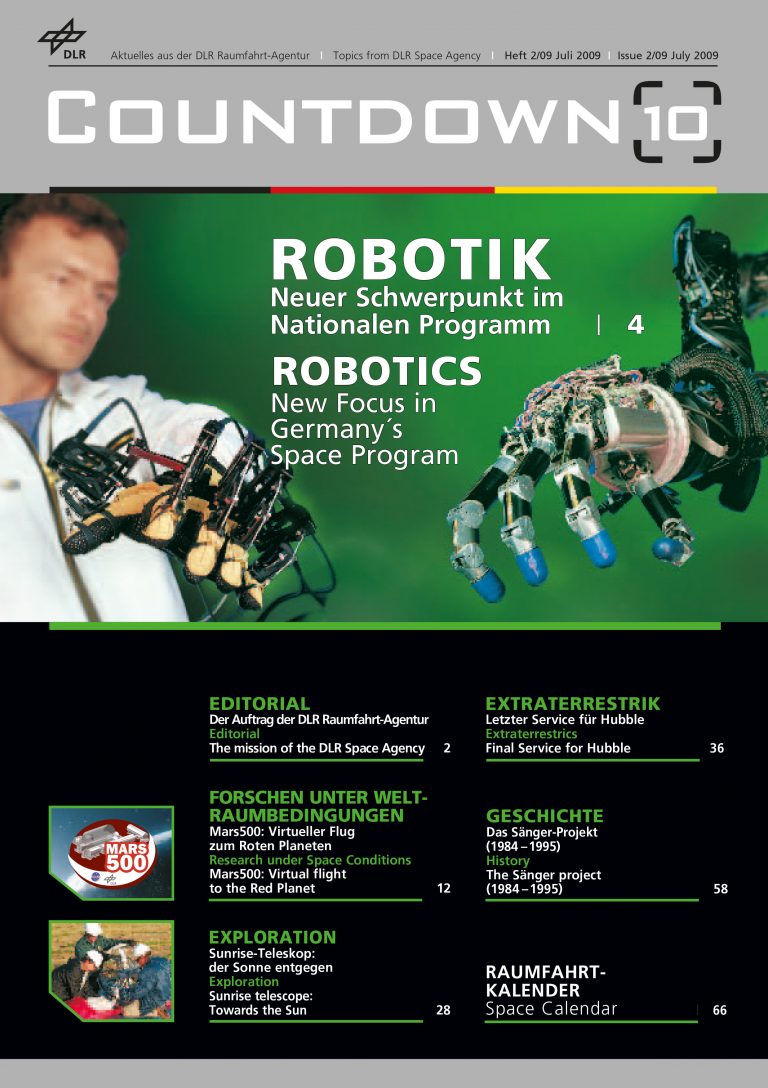
In May 2009, the first national conference on space robotics was held in Berlin. The tenth issue of COUNTDOWN reports in detail on this new focus in Germany's national space program. Furthermore, two articles are dedicated to research under space conditions: an overview of the terrestrial isolation experiment Mars500 with German contributions and an experience report on the recent research rocket campaign BEXUS 5/6 in northern Sweden. The research balloon Sunrise also took off from there in early summer. On board was a German telescope that has the sun in its sights. A summary of NASA's last inspection trip to the Hubble Space Telescope rounds off the thematic focus on extraterrestrials in this issue. Also in the issue: the new German GALILEO test bed for rail traffic - railGATE, the new German ESA astronaut candidate Alexander Gerst and a review of the "Singer" project as part of our space history series.
COUNTDOWN 9

The two space observatories of the European Space Agency ESA, Herschel and Planck, are expected to be launched in May 2009. While Herschel will provide new insights into the evolution of galaxies, Planck will focus on research into dark matter and dark energy. DLR Space Management has provided significant funding for the development and construction of several measuring instruments. In addition to the cover story, COUNTDOWN Issue 9 highlights these aspects of spaceflight, among others: space medical experiments on Columbus, Earth observation with EnMAP, Galileo testbed aviationGATE, the opening of the International Year of Astronomy, and German spaceflight in the Kohl era (1982-1998).
COUNTDOWN 8
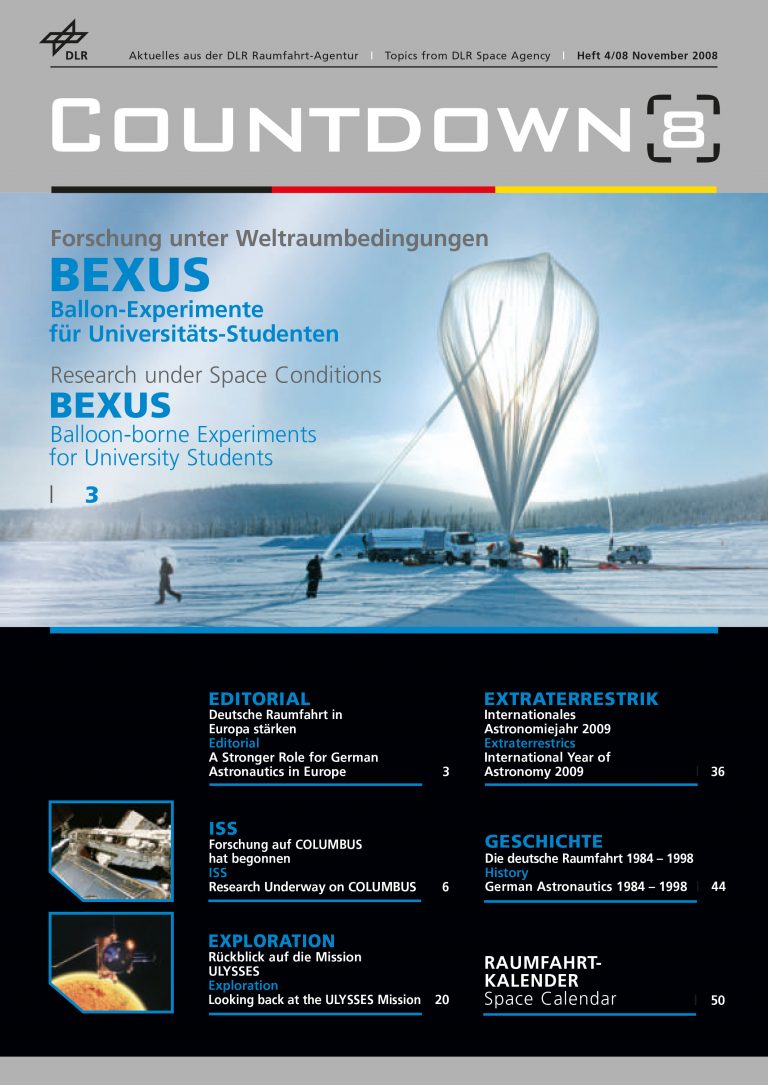
Near Kiruna in northern Sweden is Esrange, the launch site of the Swedish Space Agency SSC. Not only do the launches of the TEXUS, REXUS and MAXUS research rockets take place here, but also the BEXUS balloon program. Here, students conduct projects on research under atmospheric conditions. In the cover article of COUNTDOWN 8, Dr. Niklas Reinke reports on the most recent campaign with DLR participation in October 2008. Also in the issue: a review of the ATV mission "Jules-Verne" and of the European mission to explore the sun called ULYSSES, Our laboratory in space - research on COLUMBUS has begun, reports from the Space Triangulation Symposium in Berlin and from the International Space Congress in Glasgow, an outlook on the International Astronomy Year 2009, and the seventh part of the historical series "German Spaceflight" (The long road to the ISS 1984-98).
COUNTDOWN 7
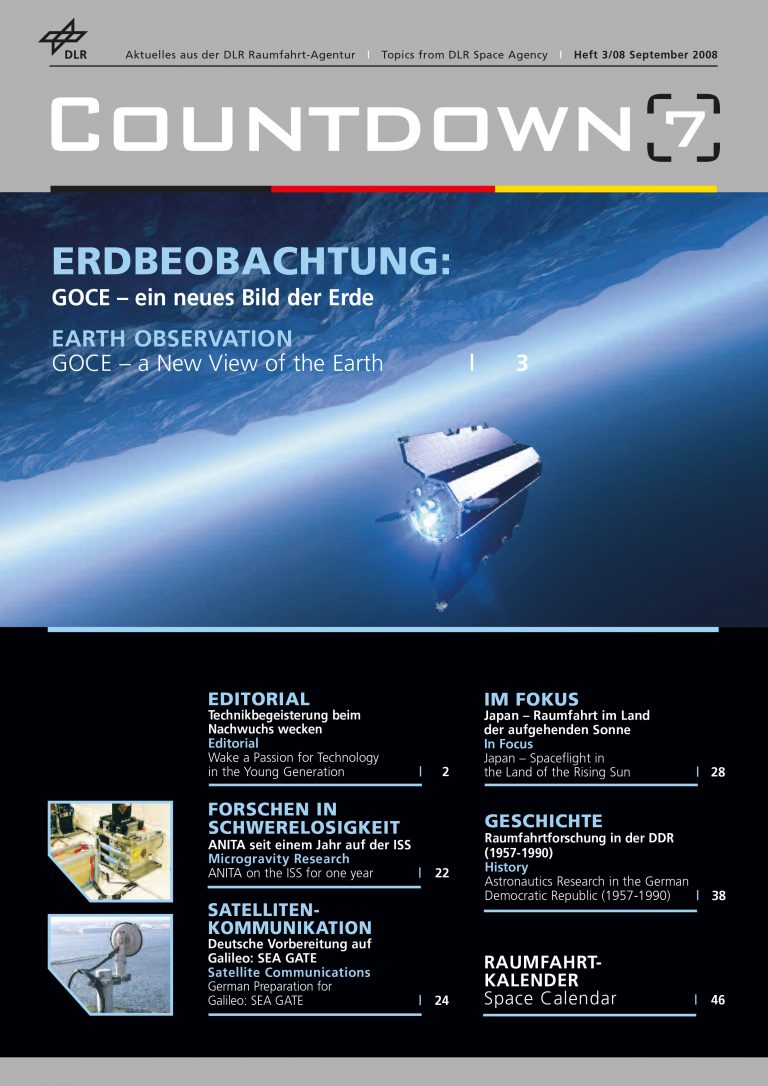
The GOCE environmental satellite is about to be launched. As part of its "Living Planet" program, the European Space Agency (ESA) has set itself an ambitious goal: to measure the Earth's gravitational field and sea-level fluctuations at a previously unattainable resolution. Through its massive financial participation in GOCE, the German government underscores its commitment to sustainable climate research and climate protection policy. In addition, COUNTDOWN 7 covers topics including: Fighting forest fires from space, SEA GATE - the maritime test environment for the European navigation system Galileo, Japan in focus and - in the historical series - space research in the GDR.
COUNTDOWN 6
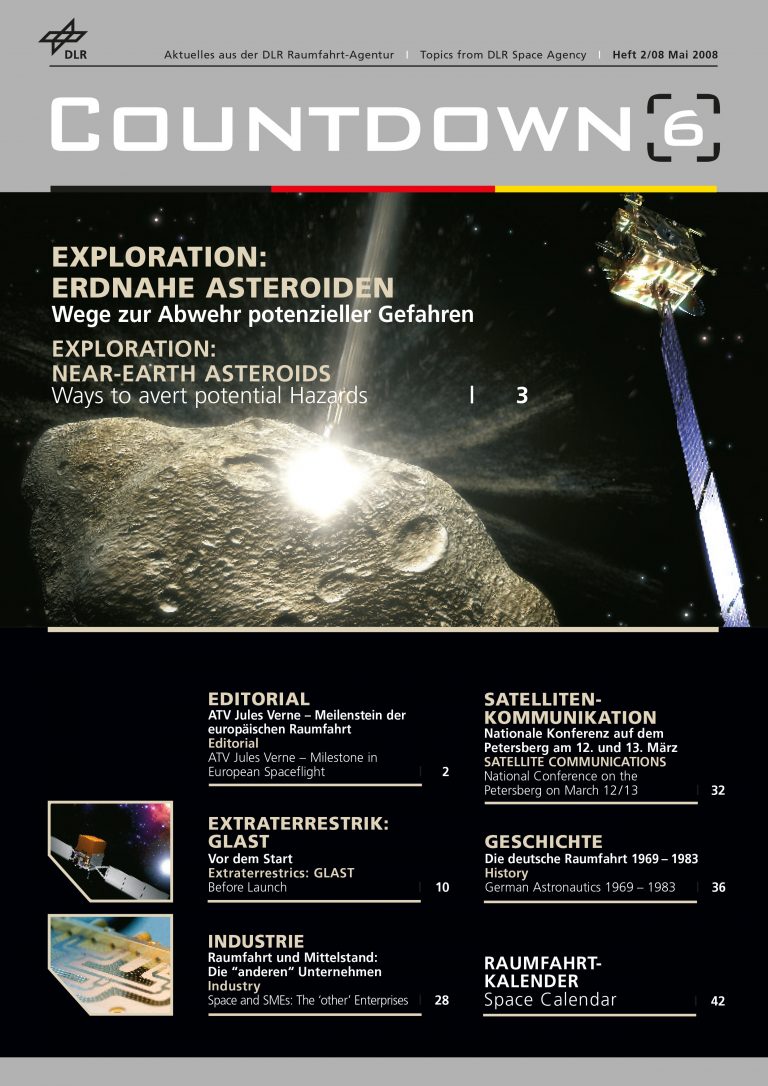
Impacts of asteroids and comets on Earth are natural processes. The effects of such "impacts" range from the penetration of tiny dust particles into the Earth's atmosphere to rarer impacts of larger bodies that form craters on the Earth's surface or create tsunamis in the ocean. The number of potentially dangerous objects - more than 150 meters and less than 7.5 million kilometers from us - is currently 929, so it's worth thinking about ways to avert the danger. Destruction or redirection of the object by chemical rocket engines, impactors, nuclear warheads or solar mirrors are approaches presented in COUNTDOWN Issue 6. Other topics in this issue: the German contribution to the U.S. GLAST gamma-ray observatory, small and medium-sized enterprises in the German space industry, and the fifth part of the history of German spaceflight (1969-1983).
COUNTDOWN 5

With the European research module COLUMBUS and the automatic transport vehicle ATV "Jules Verne", European spaceflight set off for new research worlds in spring 2008. Both ISS modules represent a clear commitment to the use of the space station even after the end of the first decade of the third millennium. Hans Schlegel was the second German astronaut to complete an extravehicular activity in space as part of the STS 122 mission, which successfully connected COLUMBUS with the ISS. Other topics in COUNTDOWN 5: the new national legal framework for the dissemination of satellite data, the Galileo test satellite Giove B before launch, and the fourth part of the history of German spaceflight (1955-1969).
COUNTDOWN 4
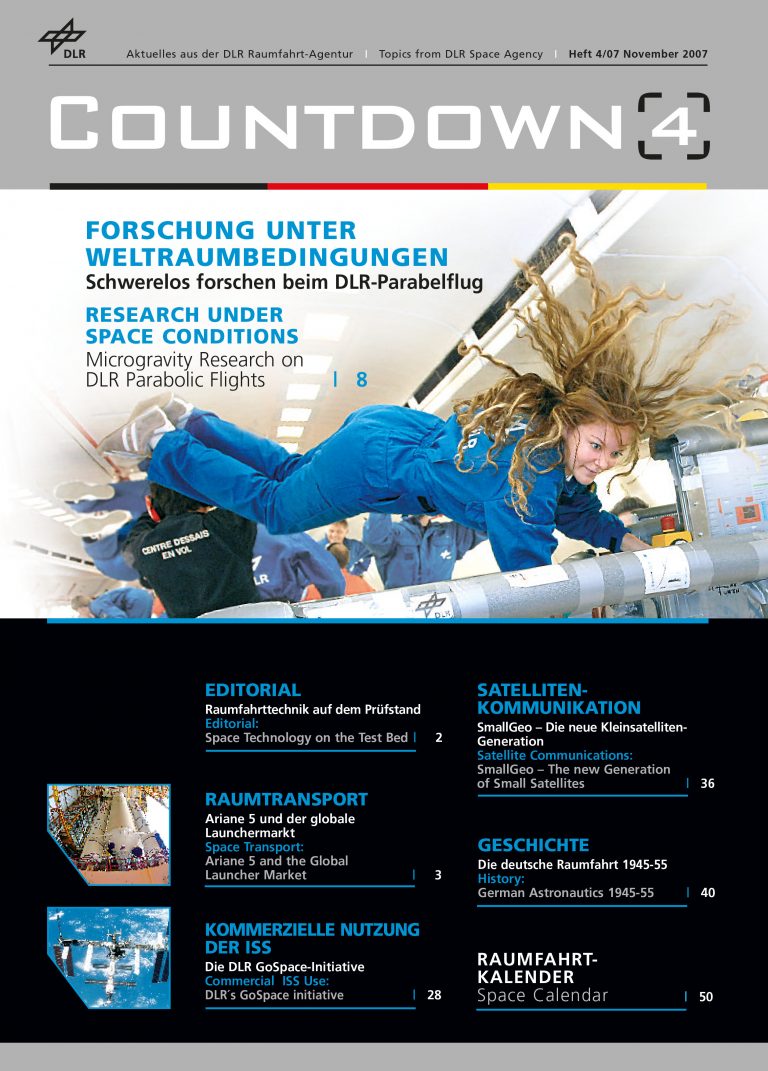
It is well known that the International Space Station provides the global scientific community with research opportunities in weightlessness. But there are other ways to overcome the Earth's gravitational pull and gain new insights in disciplines such as biology, physics, human physiology and materials research: In addition to the Texus rockets launching in Sweden and the Russian Foton satellites, the parabolic flight program, which DLR is conducting from Bordeaux together with its French partner Novespace, is particularly noteworthy. Its unique selling point is that the researchers can control their experimental facilities in free fall and thus constantly optimize measurement results. Other topics in COUNTDOWN 4: Ariane 5 and the global launcher market, the new generation of small geostationary satellites and the third part of the history of German spaceflight (1945-1955).
COUNTDOWN 3

In addition to the planned European satellite navigation system GALILEO, the Global Monitoring for Environment and Security GMES is one of the current European flagship projects in space. With these two projects, the EU wants to position itself as a serious partner on the international market for space applications. How the distribution of tasks is to be regulated and whether Europe is possibly weakening itself with this double responsibility is the subject of this issue. Further topics of COUNTDOWN 3: the German contributions to the NASA missions DAWN (asteroids Vesta and Ceres) and PHOENIX (Mars), Laser Communication Terminals - the new high-speed data link between satellites made in Germany and the second part of the history of German spaceflight (1933-1945).
COUNTDOWN 2
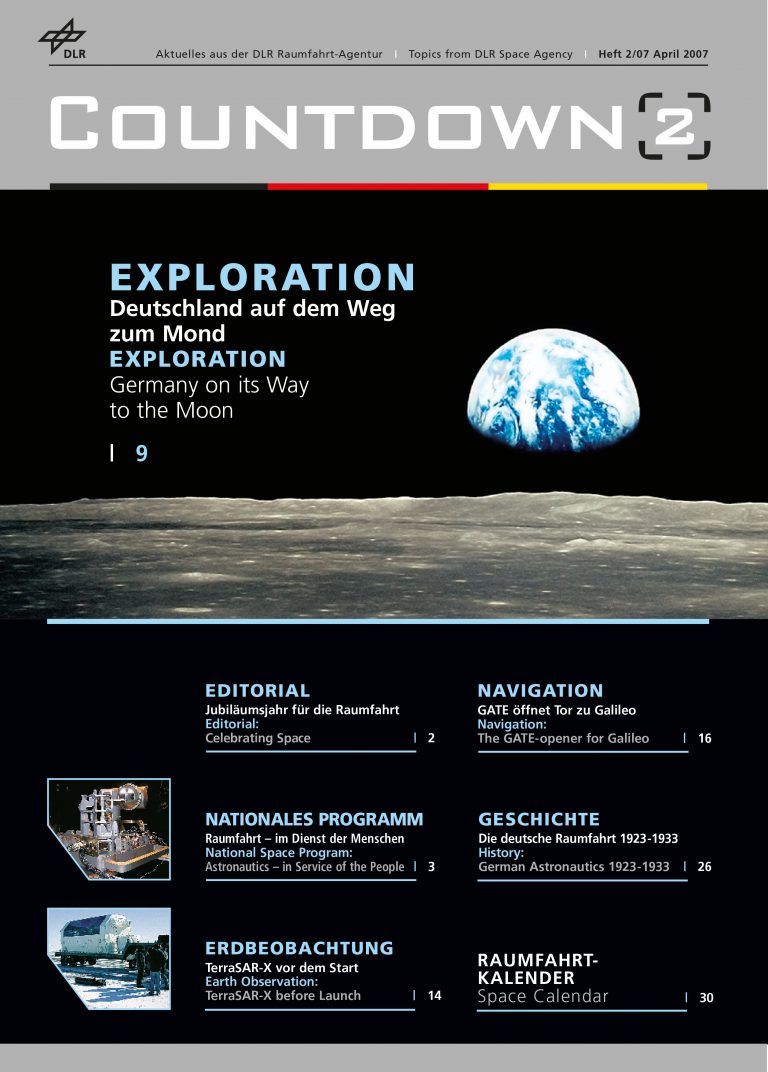
German aerospace research celebrates its 100th anniversary in 2007. Even though a large and cost-intensive area of spaceflight is concerned with exploring neighboring planets or distant galaxies, research under space conditions is at the service of people on Earth. DLR's National Space Program, which funds the development of many applications used in daily life, is one of the focal points of this issue. Other topics: GATE, the Alpine test region for the upcoming European satellite navigation system GALILEO, the European Space Agency ESA, and the first part on the history of German spaceflight (1923-1933).
COUNTDOWN 1
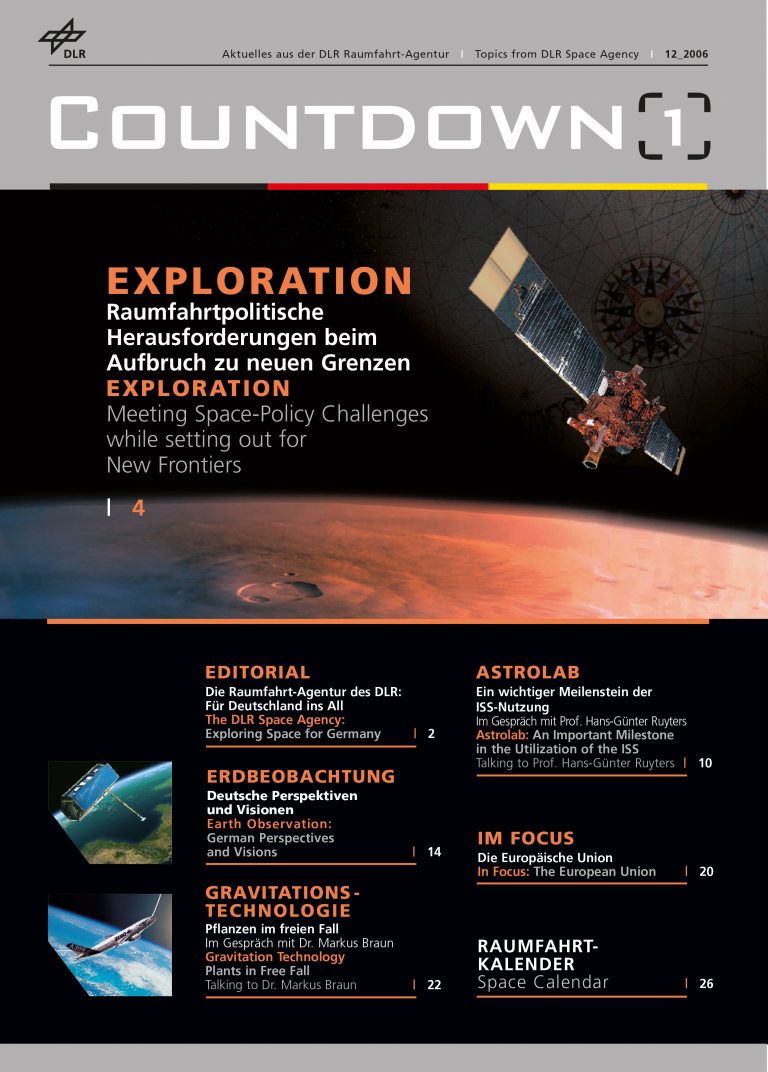
The beginning of 2007 offers the opportunity to look back on the successful ASTROLAB mission on board the International Space Station, with which Thomas Reiter advanced to become the European "record astronaut" in terms of dwell time and outboard missions in space. The first issue of COUNTDOWN also focuses on the upcoming launch of the TerraSAR-X Earth observation satellite, whose radar images are expected to provide cartographic images of unprecedented sharpness and reliability. With this first public-private partnership in the German space sector, DLR Space Management is entering new, promising territory. Other topics in this issue: The European Union as a new player in international spaceflight and biological experiments on DLR's parabolic flight.
